THE NEW BUGS ON THE BLOCK
Alternative feeder insects and the future of live foods
SNAKES AND ADDERS
After decades of decline, we look at the new threats facing the UK’s most iconic snake, the adder (Vipera berus)


WHEN LIFE GIVES YOU LEHMANN’S...
Discussing the care and keeping of the critically endangered Lehmann’s poison frog (Oophaga lehmanni) with Ross Dacre.
LET THERE BE FLIGHT
New species of flying lizards are being described every year. Jordi Janssen and Emerson Sy talk us through the Draco genus..

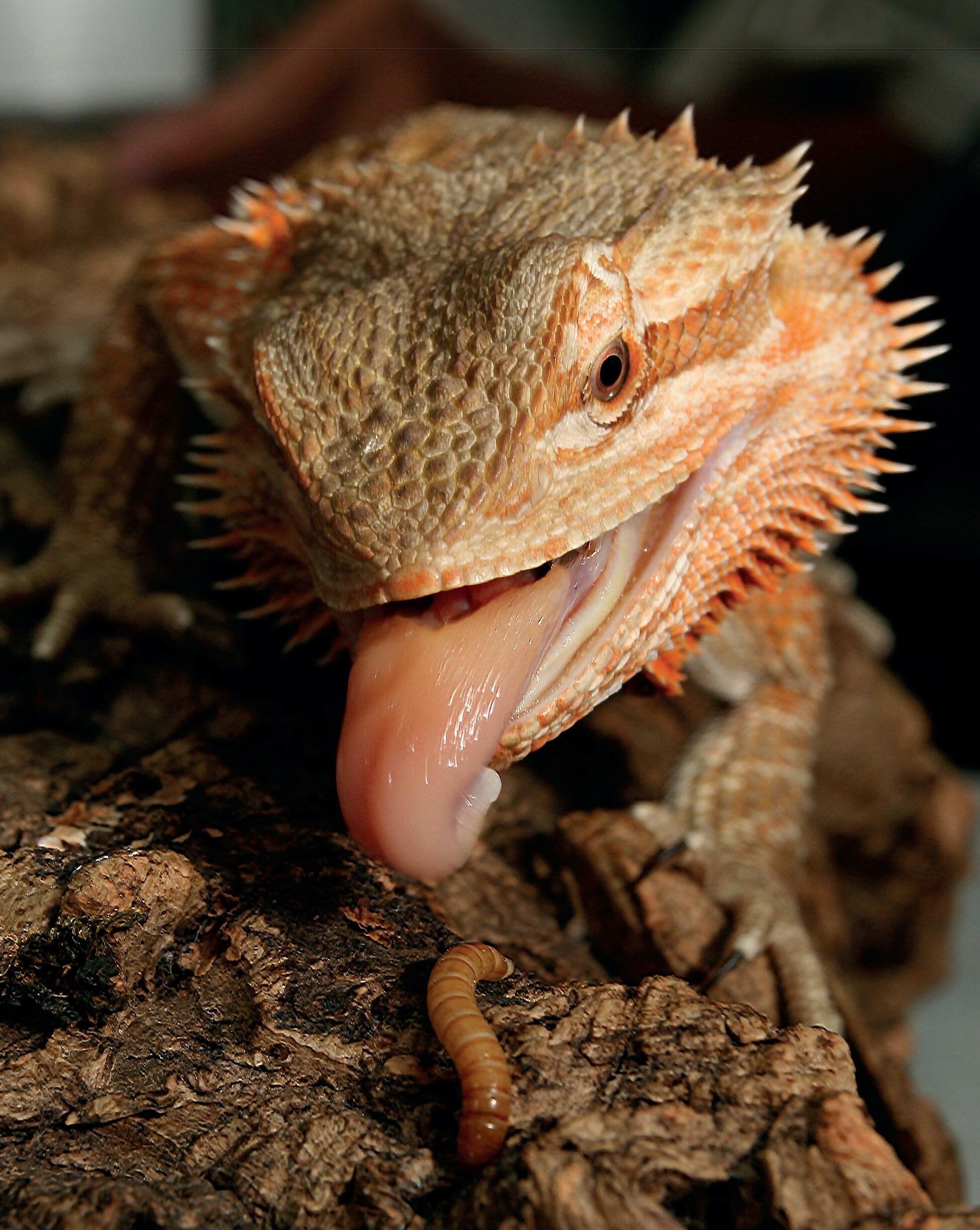
www.exoticskeeper.com • september 2022 • £3.99
NEWS • NEW FOREST CICADA • PARROT HEALTH • BEARDED DRAGON DIETS • MOUNTAIN RAT SNAKE

CONTACT US
EDITORIAL ENQUIRIES
hello@exoticskeeper.com
SYNDICATION & PERMISSIONS
scott@exoticskeeper.com
ADVERTISING
advertising@exoticskeeper.com
About us
MAGAZINE PUBLISHED BY Peregrine Livefoods Ltd
Rolls Farm Barns
Hastingwood Road
Essex
CM5 0EN
Print ISSN: 2634-4693
Digital ISSN: 2634-4688
EDITORIAL:
Thomas Marriott

DESIGN:
Scott Giarnese
Amy Mather
Subscriptions
Follow us

This month welcomed the launch of our new website. Finally, we have a platform that is a lot more user-friendly. We hope to add more content, including exclusive news pieces and features much more frequently than before. As well as Apple Pay and Paypal support, we are also providing new subscription offers to meet a range of budgets. We have very ambitious plans for the new website and this is merely the first step toward creating an educational platform for all exotics keepers going forward.
Going back to the magazine, this month we caught up with our friends at Amphibian and Reptile Conservation (ARC) for a walk around Chobham Common and talk about the demise of adders in the UK. A full video feature can be found on our website, starring two wonderful snakes we found on the day. Further afield, Herpetologists, Jordi Jannssen and Emerson Sy give us an introduction to a fascinating genus of lizard, Draco or the “flying lizards.” Working with one of the UK’s largest breeders of feeder insects, we have constructed the
confusing symptoms of a wide range of illnesses, so keepers need to stay vigilant with their birds.
Next month will be our second anniversary and over that time we have covered an immense range of topics in the world of exotics keeping. We have some very special features planned and we look forward to embarking on year three of Exotics Keeper Magazine.
Every effort is made to ensure the material published in EK Magazine is reliable and accurate. However, the publisher can accept no responsibility for the claims made by advertisers, manufacturers or contributors. Readers are advised to check any claims themselves before acting on this advice. Copyright belongs to the publishers and no part of the magazine can be reproduced without written permission.
Front cover: Bearded dragon (Pogona vitticeps)

Right: Adder (Vipera berus)

. . . . . . . . . . . . . . . . . . . . . . . . .
‘Best Aquarium Fish Food’









As voted by readers of Practical Fishkeeping magazine




Aquarium Fish Foods with Insect Meal




















Uses cultured insect meal to recreate the natural insect based diet that most fish eat in the wild.
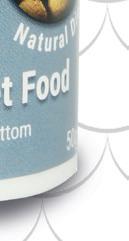









Easily digested and processed by the fish resulting in less waste.










Environmentally friendly and sustainable.

www.fishscience.co.uk
02 06 14
02 EXOTICS NEWS
The latest from the world of exotic pet keeping.
06 LET THERE BE FLIGHT! An introduction to the Draco genus.
12 SPECIES SPOTLIGHT

Focus on the wonderful world of exotic pets. This month it’s the Yunnan rat snake (Oreocryptophis p. pulchra).

14
24 32 41
THE NEW BUGS ON THE BLOCK
Alternative feeder insects and the future of live foods.
24SNAKES AND ADDERS
The new threats facing the UK’s most iconic snake.
32
41 KEEPER BASICS: The EK guide to keeping a healthy parrot.

45
WHEN LIFE GIVES YOU LEHMANN’S
Discussing the care and keeping of Oophaga lehmanni with Ross Dacre.
FASCINATING FACTS Did you know...?
46 ENRICHMENT IDEAS
Monthly tips on how to enrich the life of your pet.
EXOTICS NEWS
The latest from the world of exotic animals
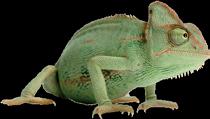
BIAZA calls for Brexit Transfer Agreement
The British and Irish Association of Zoos and Aquariums claims that important animal transfers between zoos in Great Britain and Ireland are "being prevented" and "animals can now no longer be transited through Great Britain on onward journeys into the EU". It has called for a sanitary and phytosanitary (SPS) agreement to be struck between the UK and EU to ease the restrictions. Among the breeding programmes managed in Ireland are for colobus monkeys and Francois langurs at Belfast Zoo. Nicky Needham, from BIAZA, said it was "hugely frustrating" that the transfer of animals, such as cheetahs and langur monkeys "has been made so much more difficult following Brexit". "Our zoos now face impossible hurdles and delays to partaking in international breeding programs," she outlined.

Christoph Schwitzer, chief executive of Dublin Zoo, said: "It is imperative that the UK and European Commission find a solution so that good zoos and aquariums can continue their work saving species from extinction."
Zoos and aquariums from Ireland have written to the British and Irish prime
ministers to call for an agreement on the transfer of animals- post-Brexit, they include Belfast Zoo, Exploris Aquarium and Castle Espie Wetland Centre. Their letter suggests breeding programmes are at risk because of restrictions on animal movements. It said there were "excessive and in some cases prohibitive restrictions". The signatories, members of the British and Irish Association of Zoos and Aquariums (BIAZA), have also written to the president of the European Commission, Ursula von der Leyen, the letter outlined that there were 48 animal transfers between EU and UK zoos in 2021, compared with 1,400 "in a normal year". This is completely undermining the conservation impact of BIAZA member zoos, in all these nations," it added.
Europe`s Oldest Zebra?

At Belfast Zoo, “Sandy” a female Grant’s zebra celebrated her 40th birthday at the end of July. It is believed she may be the oldest zebra in European collections, the average longevity for the species is between 25-30 yrs.
Crocodiles of the World
A clutch of American alligators have hatched to resident pair “Albert” and “Daisy”. The youngsters are currently swimming about the pool under the watchful eye of their mother. Albert is
a mature specimen and came to the centre in March 2013 at just over 10ft in length. Whilst Daisy was already a long-term resident. Daisy and Albert produced their first clutch of eggs in spring 2013, and since then they have bred a number of times, the off-spring are used in educational programs, or are sent to other zoos around Europe. This species is known for their excellent parenting skills.
Cambridge Corvid Research Facility Saved
The renowned “corvid palace” – a research facility at the University of Cambridge has been saved from closure by public donations.

The centre for research on bird intelligence at the University of Cambridge has been saved from closure by a campaign kick-started by the New Scientist, which raised £500,000 from public donations in a matter of weeks. Together with support from the university, the campaign has secured the facility’s immediate future.
In May, it was reported that the 25 jays and seven rooks in Nicola Clayton’s Comparative Cognition Lab, would have to be rehomed, as it was facing closure in July due to Brexit and pandemicrelated funding difficulties. Donations from the public to support the lab also


2 SEPTEMBER 2022 Exotics News
©Belfast Zoo
A pair of rooks at the Comparative Cognition Lab ©Francesca M. Cornero/ University of Cambridge.
rolled in, totalling £500,000, which will keep the facility running for the next five years. “I’ve been overwhelmed in the most positive way by the support from the University of Cambridge, fellow academics and the general public from all walks of life,” says Clayton. “Every penny I’m so grateful for. It’s been an emotional roller-coaster, with a heart-warming, positive ending.” The facility was founded 22 years ago by Clayton and since then it has been key to understanding the cognitive abilities of corvid species (the crow family).
in terms of chick loss”. "Coquet is the only place where you'll find them, last year there were 150 pairs so that's a species on a knife edge anyway. But they have been doing well every year until this year, increasing brilliantly at the start of the season, but then bird flu hit three or four weeks ago and it's just been working its way through the population." “If bird flu deaths were limited only to chicks, it would cause a "glitch" in the population but adults could still return to breed next year and over time the population would have the possibility to recover”. Paul says the fact that adult birds are dying as well is "really serious."
"We are operating in full PPE and have fences to separate the different species of chicks - of course, the adults can fly. At every point on the island we're disinfecting our boots so we don't spread the disease and we're removing corpses because they are the source of bird flu infection." "It's a very strange illness. Overall, it's absolutely devastating, this is the worst season I've ever seen and I've been there for 38 years."

The UK Health Security Agency (UKHSA) continues to advise that the risk to the general public's health is very low, but people should not touch sick or dead birds. If found, please report any dead birds to Defra on 0345 9335577.
Bird-Flu Devastating Seabirds
Recently the U.K. has seen a surge in cases of Avian flu in seabird species not seen here before. In the past most avian flu cases have affected waterfowl and domestic fowl, but this year it appears that a new, perhaps more virulent, strain has taken hold of our native seabird species, and is the most widespread outbreak so far to hit the U.K. Those affected include various gulls, several species of tern and the Northern gannet colony on Bass Rock in East Lothian –which is the largest gannet colony in the world. In Shetland at least 1,000 gannets have died and hundreds of great skuas. The disease has been recorded on St Kilda which is home to the largest colony of Atlantic puffins in the U.K.
Another important seabird colony is Coquet Island, an RSPB sanctuary off the Northumberland coast, here can usually be found the only nesting roseate tern colony in the U.K. – normally with around 150 breeding pairs. There are also Sandwich, Arctic and common terns on the island, with bird flu affecting all four species, resulting in serious losses of chicks. Several adult birds have also died, which could severely affect seabird populations in the coming years.
Paul Morrison, RSPB Warden for Coquet Island, said: "The common terns were the first to fall victim to bird flu with the loss of the adults, and then it spread to the Arctic, then Sandwich, then the Roseate terns. We've now lost two thirds of the Roseate tern chicks and that's absolutely catastrophic
New Legless Lizard Species
A team of Australian Museum scientists have described the Hunter Valley Delma as the first legless lizard species endemic to New South Wales. A team of scientists from the Australian Museum has officially confirmed that a legless lizard from the Hunter Valley represents a new species to science, now named the Hunter Valley Delma (Delma vescolineata).
Previously confused with a very similar-looking species with a much wider distribution further south, the new species is known only from the Hunter Valley and Liverpool Plains of New South Wales (NSW). With a relatively small range under increasing habitat modification, NSW’s only endemic legless lizard is a significant addition to the

3 SEPTEMBER 2022 Exotics News
©Stephen Mahony/Australian Museum
Clearing away the dead birds on Coquet Island doing so in full PPE to minimise the risk of bird flu ©Paul Morrison/RSPB
diverse and often threatened reptile fauna of Australia, and a priority for further research.
The Hunter Valley Delma (Delma vescolineata) was first found in 2012 by a local herpetological enthusiast Ryan Harvey and was initially considered a new population of the Striped Delma (Delma impar), however, this population looked somewhat different – it had barred lips and wasn’t as strongly striped, so the team at the Australian Museum began an investigation.
To confirm whether the species was indeed distinct, the team had to compare genetic samples to those from the Striped Delma from southern NSW. They also had to compare the physical features of the species to other similar legless lizards and in doing so they found that in addition to barred lips and weaker stripes there were also subtle differences in scales and head shape. The new species scientific name means “weakly striped”, a comparison to the Striped Delma found further south.
The Hunter Valley, where the lizard was discovered, is only two hours from the city of Sydney, so it is amazing how long this species went undetected. This is partially explained by its cryptic nature, living down burrows, in dense grass tussocks, and under rocks and fleeing rapidly when disturbed. It is also probable it was found earlier and assumed to be the Leaden Delma (Delma plebeia) which also occurs in the Hunter Valley. The Hunter Valley Delma is only found in the Hunter Valley and the nearby Liverpool Plains and like other related species it prefers open grassland habitats. The Hunter Valley Delma can be locally abundant in some environments and even seems to display a tolerance for disturbance, being found in very weedy, cleared, and grazed areas. However, the small area it is known to occur in and threats like loss of habitat to mining, development and cropping make it likely to be considered threatened with extinction. Further research into the ecology of the species will help determine what threats impact it the most and what actions could be taken to protect it.
Rare Zoo-Bred Tadpoles Released in Puerto Rico
Potter Park Zoo, in Lansing, has recently sent nearly 2,000 Puerto Rican crested toad tadpoles to Puerto Rico for repopulation as part of their ongoing release programme.

The species has been bred and reared in the zoo since the 1980s, in carefully controlled environments designed to replicate their natural habitat. A small population was found in the late 1960s – having been previously thought to be extinct. The crested toad is the only native toad in Puerto Rico in the Caribbean and all the animals are owned by the Puerto Rican Government – who initially loaned the adult toads to the zoo for breeding.
The zoo have been involved in the release programme since 2009. Once hatched the tadpoles are kept at the zoo for a week before being transported to the airport by the company FedEx, here they are met by the zoos partners who then take them out to the releases ponds. These areas are protected sites, and it is common to see tadpoles already present – these are the offspring from previous releases, so it is clear to see that the species is breeding in the wild.
ON THE WEB
Websites | Social media | Published research
Each month we highlight a favourite website or social media page
THIS MONTH IT’S: US!
That’s right. This month we’re taking a look at ourselves. We have a brand new website, which will be regularly updated with exciting and interesting content. Have a browse now and let us know what you think, or send over any content requests to hello@exoticskeeper.com.
www.exoticskeeper.com

4 SEPTEMBER 2022
Exotics News
Collated and written by Paul Irven.
©A pair of Puerto Rico’s Crested Toads photographed at Lansing’s Potter Park Zoo.

LET THERE BE FLIGHT
An introduction to the Draco genus.

6
Common fying lizard (Draco volans)

The flying lizards of Borneo have featured in nature documentaries and amazed viewers across the world for decades. Many people know that there are lizards capable of gliding long distances from tree to tree, but few understand the rich diversity of these lizards. Falling into the Draco (meaning ‘dragon’) genus, there are around 40 completely different species of ‘flying lizard’. These can be found across the entirety of Southeast Asia. They are mostly diurnal and exhibit unique and vibrant dewlaps which they use to communicate to one another across their forest habitats. With more species of Draco lizard being described each year, herpetologists are only just uncovering the true extent of flying lizard speciation.
A constantly evolving challenge
Emerson Sy and Jordi Janssen are herpetologists from the Philippines and the Netherlands, respectively. They have recently co-authored “A Naturalists Guide to the Lizards of Southeast Asia” which allows enthusiasts to correctly identify the herpetofauna of the region. The co-authors met in Malaysia whilst working for TRAFFIC. Both are still working on researching the wildlife trade for separate organisations. “We found some challenges in writing the book” explained Jordi. “For example, when we started writing the book there were just over 900 lizard species described in Southeast Asia. When we finished there were over 1100. We set a taxonomic cut-off date for the book and a week later another 12 were added!”
Emerson added: “The biogeographic history of Southeast Asia is quite dynamic. It is more complex than what has been reported and more information is coming out about micro-endemism, particularly on islands. Occasionally we will find that a certain species on the West side of an island is more closely related to the one on the East side, rather than the ones in the centre. This is really to the credit of the molecular work of taxonomists.”
An example of this is the common flying lizard (Draco volans). This species was previously thought to inhabit Thailand, Vietnam, Malaysia, Indonesia, and the Philippines, meaning many ecotourists and holidaymakers
8 SEPTEMBER 2022 Let There Be Flight
had observed and photographed the species. Now, it has been split into several distinct species and only exists on the islands of Bali and Java. Part of the reason for this rich biodiversity is based on Southeast Asia’s dynamic land bridges throughout time.
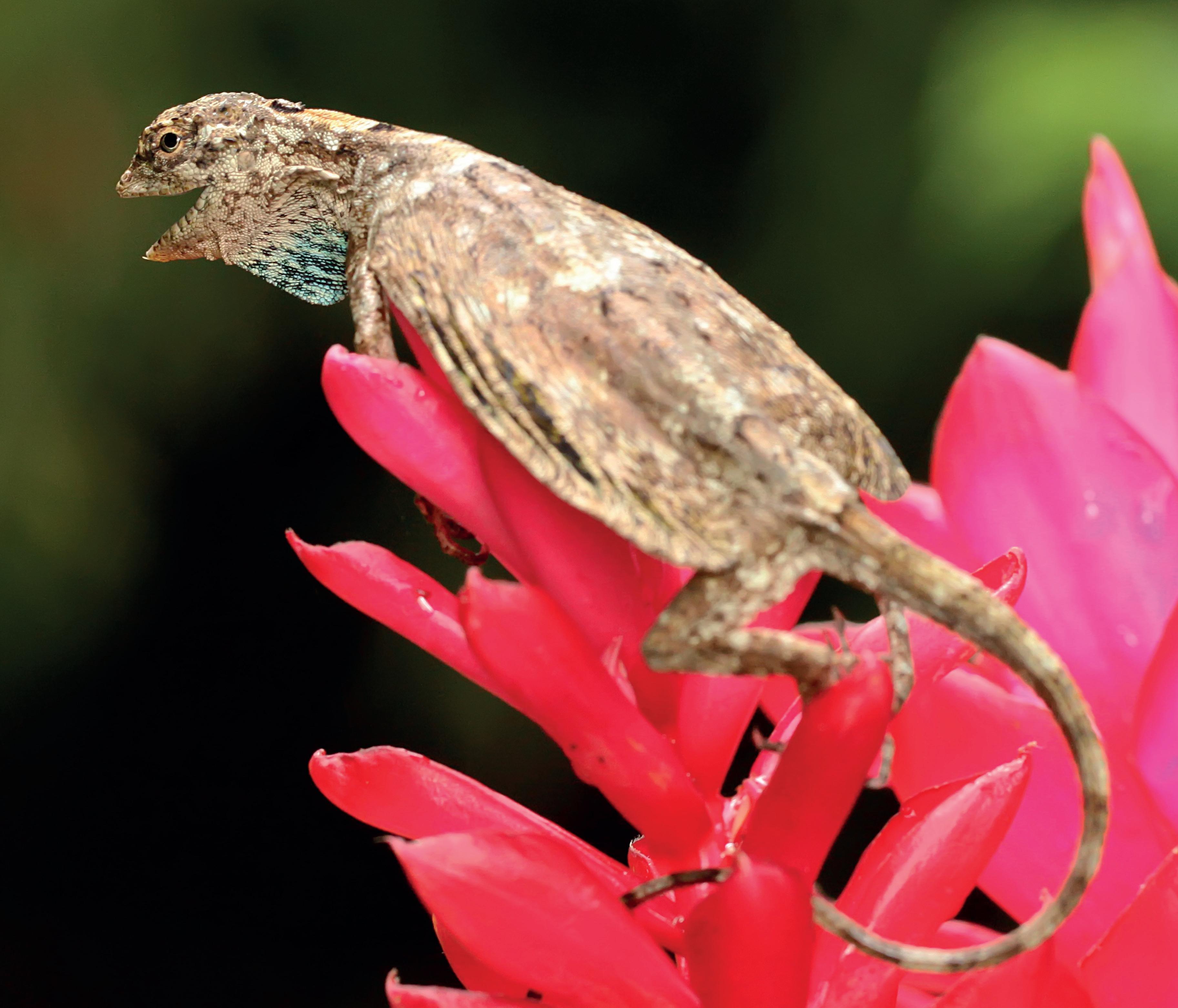
“M ost of the current islands in the Philippines were uplifted from the sea floor” added Emerson . “As sea levels dropped, some islands in western Philippines such as Palawan Island were connected to parts of Borneo This meant that wildlife could migrate to those islands. There are still a lot of undescribed biodiversity, especially in archipelagos such as Indonesia or the Philippines. Researchers are unravelling species thought to be widespread are in fact composed of several cryptic species”
Here be dragons
Draco lizards are slender-bodied agamids from Southeast Asia. They vary greatly in size and colouration but are typically characterised as small, lowland forest lizards. “They are very diverse” explains Jordi. “Some species do really well in human-dominated environments, and they can be seen in parking lots, in high trees and others do well in agricultural areas such as in plantations. There are also some species which are only found in natural forests. Now there are around 40 recognised Draco species. However, there are likely to be many undiscovered Draco species. Some scientists estimate that there are around 45 – 50 species out there. They are a very interesting genus of agamid in that they are strictly arboreal. Males are only found in the trees. Females will venture to the ground to lay eggs, but other than that they only live in the trees.”
9 SEPTEMBER 2022
Let There Be Flight
Draco lizards, sometimes referred to as ‘flying’ or ‘gliding’ lizards are famed for their ability to glide from tree to tree to evade danger. Their flying techniques are extremely advanced, and the lizards have developed ‘patagium’ (pl. -patagia) which is the skin that extends from their body to allow them to glide. Unlike other gliding species, this is operated by the lizards’ bone structure. The lizards have either five or seven elongated ribs, they can be spread by specialised intercostal muscles. Once spread, the patagia covering the ribs allow them to glide up to 50m from tree to tree. This unique approach to ‘flying’ means that the lizards have full use of their limbs as they take off and land and recent research suggests they use their arms to direct
their flight path more effectively. Draco also has throat lappets which can help them gain lift and assist balance.
Draco lizards present some aspects of convergent evolution with Anolis spp. For example, both are diverse genera of lizards that are highly territorial and must communicate with other individuals to protect their territory and find a mate. Their vibrant dewlaps can be used to translate various messages. “One reason why Draco and Anolis lizards have both evolved dewlaps is that they are the prey of arboreal snakes, so they need to communicate quietly to avoid predators” explains Emerson. “The gular dewlap varies greatly in size and colour. They will also use colouration to display their mood in other ways. For example, they have very different colouration when they’re in their relaxed state, compared to when they are in a researcher’s hand. This is a real challenge for taxonomists looking at preserved specimens, compared to looking at them in the field – it is very hard to distinguish them. Like many agamids, they will turn much darker as a stress response.”
Male Draco lizards will also use their dewlap as a warning to other males in the area. Interestingly, not all species are sexually dimorphic, and it can be very difficult to distinguish males from females. In some cases, the females are as colourful as the males. For example, Draco ornatus, or the ‘white-spotted flying lizard’ can be found in the Philippines and is one of only two species of Draco where the females have brighter patagial colouration. Females of this species are also much larger than the males.
Slaying the dragon
Although some species of flying lizards are very adaptable and have learnt to live alongside humans, habitat destruction is still a significant threat for localised populations. Across Southeast Asia, many recently described species have been identified from localised populations of an otherwise abundant species. This means that even the most widespread of animals, in some regions, could contain brand new species that need conserving. “All of them will be threatened in some form or another” added Jordi. “Usually this is from habitat loss or degradation. The IUCN listings state most species, except a couple are considered ‘least concern’. However, there will be many populations that are threatened at a localised level.”
Habitat destruction is not the only thing threatening localised populations of Draco lizards. Emerson added: “There are cases of Draco lizards being used in traditional medicines too. They sundry the lizards before roasting them over a grill and use the powder to mix with water, as a treatment for asthma and other respiratory ailments. This happens in a few places in the Philippines, and I would imagine it happens in parts of Indonesia too.” Whilst small-scale hunting for local medicines is generally a lesser threat than deforestation, it can have a huge impact on vulnerable island populations. Preserved specimens of these lizards are also sold as novelty items and decorations online. The source of these dead specimens is ambiguous but perhaps highlights an area of concern.

10 SEPTEMBER 2022
Pick up
Spreading your wings
Historically, Draco lizards have not thrived in captivity. Although they are often abundant in their origin countries and inhabit areas where legal exports are still ongoing, they are much more fragile than that there is a high mortality rate during transport and the few that do survive will frequently perish within their first month in captivity. As most species are abundant, even zoological institutions have chosen not to exhibit these unique animals as there is very little conservation interest in exporting and establishing breeding colonies of Draco lizards.
Jordi continued: “There has been some trade of Draco spp., but they are notoriously difficult to keep in captivity. As far as I know, only two people have been reasonably successful at keeping and even breeding them. People don’t know why they are so hard to keep. Some believe it has to do with hydration, others blame their specialised ant/termite diet but really, no one knows. They are not CITES listed, so trade is not documented for these species. We know that it does happen, but we rely on hobbyist reports to keep track of this.”
Although hobbyists have kept some species in the past, they are not routinely bred, and they are generally aggressive towards one another in a captive environment. Whilst their delicate nature means it is highly unlikely that reptile enthusiasts will see these animals in captivity any time soon, observing them in situ is quite lizards are diurnal and as they are gifted with such an advanced escape mechanism, are extremely bold lizards that are easy to spot. Herpetology enthusiasts can visit a whole number of easy-to-access national parks across Southeast Asia to observe and photograph newly-described species without having to trek to remote locations. Jordi concluded “Lizards of Southeast Asia is designed to be the perfect guide for anyone from holidaymakers to budding herpetologists. It doesn’t feature detailed diagnostic features like scale counts etc, but it does allow people to correctly identify a large number of lizards they can encounter in Southeast Asia.”



11 SEPTEMBER 2022
“A Naturalists Guide to the Lizards of Southeast Asia” in all good booksellers now
SPECIES SPOTLIGHT
The wonderful world of exotic animals
Yunnan Mountain rat snake (Oreocryptophis p. pulchra)
The Yunnan Rat Snake (Oreocryptophis p. pulchra) originates from the tropical mountains of South China. It belongs to the Oreocryptophis genus, commonly referred to as ‘red bamboo snakes’ and is comprised of six distinct subspecies that inhabit a broader range of East and Southeast Asia.

The Yunnan subspecies inhabits mid to upper elevations in the foothills of the Yunnan Mountains, where it is remarkably cryptic, opting to hide within mosses and bark for most of the day. Naturally, they prefer cooler temperatures and display crepuscular behaviours. This species has been kept in captivity for decades but is still one of the lesser-known rat snakes. Although, this is likely due to availability, as they are reasonably straightforward to care for. Keepers should ensure that the enclosure is dense with hiding places, cork bark and a very thick layer of Bio Life Forest or coir to bury deep into. This is best achieved in a bioactive enclosure that is both visually appealing and enriching for the snake.
Yunnan Mountain rat snakes should be kept between
22°C and 25°C. Temperatures higher than 28°C are likely to cause distress and could be harmful long-term. Ferguson Zone 2 lighting should be provided, but as this subspecies is likely to inhabit more densely forested areas, it is important to ensure that it has plenty of hiding opportunities and gradients within the enclosure.
They are vibrant snakes, with ‘reddish brown’ coloured skin and black banding down their bodies and black patterns on their faces. When fully grown they can reach up to 3 ft in length. Their reasonably simplistic environmental conditions, combined with their manageable size means that these, amongst other ‘porphs’ are growing in popularity. Although pulchra is perhaps the most recent of the bamboo snakes to become established in captivity, they are not considered difficult to breed.
Porphs generally have an excellent feeding response. This can sometimes be an issue as they are ambitious with prey sizing so keepers should consider feeding multiple mice, as opposed to one rat. Keepers should also be careful not to use their enthusiasm as a justification to feed too often – once a week should be fine. Anecdotal reports suggest that these animals are less likely to fatten up or produce more eggs because of overfeeding.
Species Spotlight
With 20 years of research and development Repashy Superfoods have refined the ultimate range of premix reptile diets, inset gutload formulas and supplements. Fortified with vitamins, trace elements and minerals.








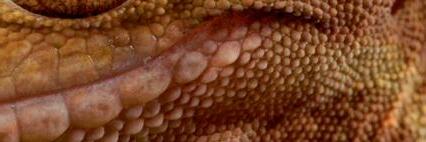
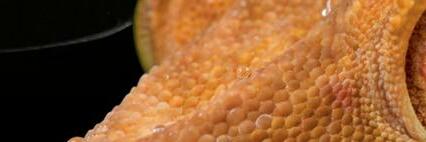


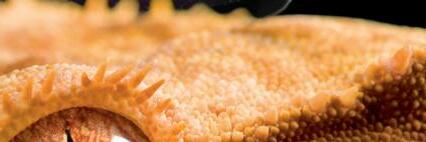

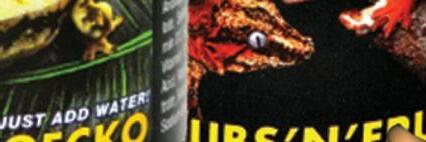























SPECIALITY PET PRODUCTS
THE NEW BUGS ON THE BLOCK
Alternative feeder insects and the future of live foods.

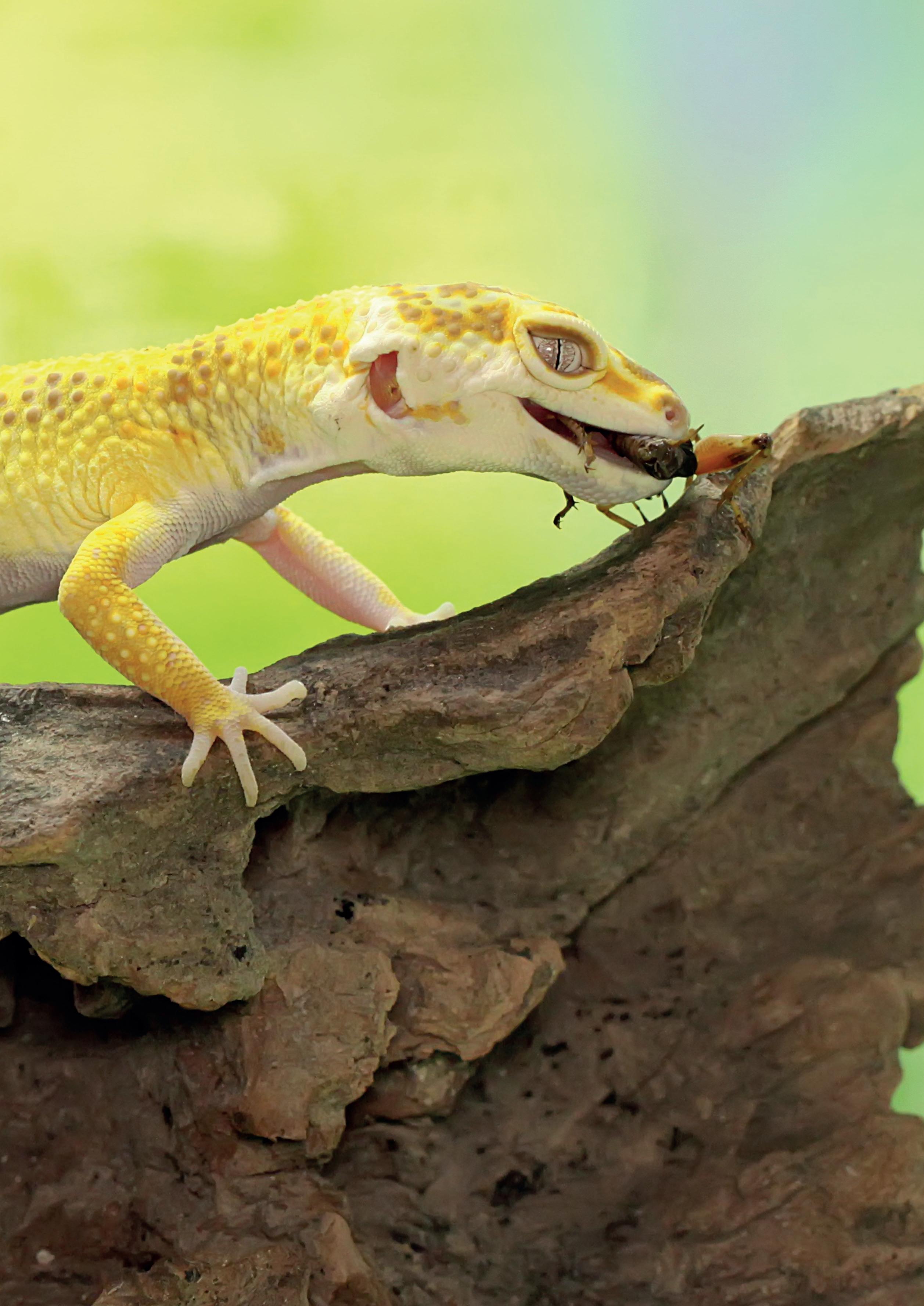 Leopard gecko (Eublepharis macularius)
Leopard gecko (Eublepharis macularius)
Many of the UK’s most popular exotic pets are insectivores. In the wild, insectivorous diets are generally very diverse. In some cases, hundreds of different species of invertebrates will be consumed in different proportions as the seasons change to form a complete nutritional profile. Whilst it would be near impossible to replicate this perfectly, research and breakthroughs in insect-breeding means there are now more reptile food choices than ever before. Not only do model species fill certain niches (such as beetles, grubs, flies, molluscs and more), but the number of sizes and alternative species within these categories allows for almost all insectivores to receive a diverse and varied diet.
Small-sized prey
Bean weevils
(Acanthoscelides obtectus)
Bean weevils are small beetles, often considered pests in the US. Naturally, they breed prolifically and are a popular feeder insect for small species of frogs, geckos and mantids. Unlike other beetles, bean weevils are comparatively soft-bodied and are therefore much more digestible than other chitin-rich live foods and still contain a good amount of calcium. Keepers should exercise some caution when providing them to young Dendrobates or mantella spp. Froglets with insatiable appetites will gorge themselves on prey items. In the
case of bean weevils, their nutritious shell can take a little longer to digest than fruit flies. This is unlikely to cause a problem for larger species such as Dendrobates tinctorius, Adelphobates galactonotus or Phyllobates teribilis and larger morphs of Dendrobates auratus However, thumbnail poison frogs and even some smaller Dendrobates spp. might have trouble feeding on them over a prolonged period. Small lizard species such as Anolis, Phelsuma and Lepidodactylus will all readily feed on bean weevils. These tiny beetles will quickly disperse across the enclosure, giving communal lizards some healthy competition whilst hunting their prey.
Bean weevils are also perfect for much larger lizards. In fact, bearded dragons (Pogona vitticeps) love them. In the wild,
16 SEPTEMBER 2022 The New Bugs on the Block
invertebrates make up only about 15% of an adult bearded dragon’s diet and almost all of these are termites. Centralian bearded dragons have evolved to feed on very small prey as termites and flies are some of the most abundant insects in the Australian outback. Bean weevils are possibly the closest alternative that keepers can provide. Pet ‘beardies’ are often spoilt in their dietary requirements, so it might not seem natural for a keeper to swap a nice juicy silkworm for a tiny bean weevil. However, this is one of the easiest and most natural enrichment techniques the keeper can provide on top of a natural enclosure.
Keepers can purchase a bean weevil culture. Which, on the surface looks like a plastic tub full of beans and wood wool. Over three weeks, the bean weevils will emerge from the beans and live for around one more week before dying. This means that a single tub will keep producing bean weevils for up to a month, so new keepers mustn't throw the box away too soon. Although they should never be used as a single, primary feeder insect, they can make the perfect backup option.
Springtails (Collembola sp.)
These are another invertebrate species used predominantly in bioactive enclosures, but again, they’re fine for use as a live food item for very small animals. Springtails are particularly popular with amphibian breeders who need the smallest possible prey for newly metamorphosed froglets and toadlets. Springtails are the perfect clean-up crew in a bioactive set-up but can also be easily cultured outside of the enclosure. Their tiny size only really makes them appropriate for a small selection of animals.

Curly wing flies (Musca domestica)
“Curly wings” are house flies with a genetic mutation that prevents them from flying. They are excellent for young chameleons and small gecko species. Bumblebee toads (Melanophryniscus klappenbachi) will actively hunt these flies and being such a small species, will only require a reasonably small feed. They are also fast-moving and encourage the animals to strike with precision. This provides incredible observation opportunities when fed to predatory inverts such as jumping spiders, young mantids and assassin beetles. Their erratic movements also make them perfect for aquatic animals such as axolotls and tropical fish.
As larger-bodied flies, they are more nutritious than D. hydei or D. melanogaster and can be gut-loaded before they are fed. There are a number of gut-loading formulas commonly used for crickets, locust and meal worms that are also ideal for curly flies. Shops will generally sell pupae, which will continue to hatch over a few weeks. Keepers can slow down this process by keeping the pupae in cooler conditions, making them the perfect feeder insect for people with busy lifestyles.


17 SEPTEMBER 2022 The New Bugs on the Block
Bean weevil (Acanthoscelides obtectus)
Springtails (Collembola sp.)
Springtail (Collembola sp.)
The New Bugs on the Block
Wax Worms (Galleria mellonella)
Wax worms are another extremely popular “worm”. However, their nutritional value is relatively poor in comparison to new feeder insects.

The wax worm’s diet means that their gut is filled with sugary food, making them very appealing to animals, but not necessarily nutritious. These bugs should be fed sparingly, either as a treat or to help an animal put on some much-needed weight fast. Provided they are fed as part of a balanced diet, they can make an interesting addition to most insectivorous diets.
However, keepers should be careful not to overfeed them, particularly to amphibians that can develop a fondness to them and become picky with other insects. With other similar sized/shaped prey frequently available, wax worms should only be fed sparingly.
Calci-worms (Hermetia illucens)

Calci-worms are the larval stage of the Black Soldier Fly and an ideal alternative for wax worms. They have a much better nutritional composition and have a longer shelf life. Again, these probably shouldn’t be used as the mainstay of an animal’s diet. But if you’re looking to add some variety to your animal’s diet these are a great choice.
Across the globe, they have adorned various names including phoenix worms, repti-worms and black soldier fly larvae. They are the grub of Hermetia illucens, which is a type of fly (though they do look like small wasps) that can be found across North America. Their UK name of ‘calciworm’ is extremely fitting as they can contain over 20X the amount of calcium of a similar-sized cricket.
Their calcium to phosphorous ratio is also near perfect (1.5:1), meaning that they can be fed without additional supplements. Although variety is key to an enriched diet, feeding larger volumes of calci-worms, particularly to hatchling reptiles, can be extremely beneficial to their development rates. Calci-worms also contain large amounts of lauric acid. This compound is extremely beneficial to reptiles, as its anti-microbial properties can even flush out nasty parasites.
 Wax worm (Galleria mellonella)
Calci-worm (Hermetia illucens)
Buffalo worm (Alphitobius diaperinus)
Wax worm (Galleria mellonella)
Calci-worm (Hermetia illucens)
Buffalo worm (Alphitobius diaperinus)
Buffalo worms
(Alphitobius diaperinus)
Buffalo worms are like mealworms but much smaller and have a softer, easier-to-digest exoskeleton. They are often much livelier than mealworms and therefore can be very enticing to animals which are struggling to feed or have sensory issues that affect their hunting response.
Their nutritional profile is like that of a mealworm – high in protein and fat, with a calcium phosphorous ratio of 1.7 (meaning they need additional calcium). In fact, buffalo worms are frequently sold as dried food for humans. Researchers at Kings College London found that buffalo worms have very high levels of iron, and this can be absorbed more easily than alternative food sources.
Buffalo worms’ soft shells make them ideal for small birds and amphibians who might struggle to take on a crunchy mealworm. As they can bury and pupate into small beetles, it is advised that they are fed within a dish. Although the beetles are harmless, a handful of buffalo worms can quickly disperse, leaving your pet with an empty plate.
Medium-sized prey Snails
(Helix aspersum)
Their slow-moving nature, along with the nutritious lump of calcium on their back are probably their main points of appeal. That said, the shell of captive-produced snails, such as those sold in most stores, are thinner due to them being grown quickly, making them much easier to eat. monitor lizards, tegus and even bearded dragons will love snails, as will blue-tongue and pink-tongue skinks. Some species will also feed exclusively on snails, namely: snaileating snakes ( ). Beware that some animals will love them so much they become picky, but as an occasional addition to an otherwise varied diet, snails are an excellent addition.
There are plenty of ways to provide snails to our animals. In some cases, live snails are undeniably the best choice. Large toads and snail-eating snakes are unlikely to eat dead or preserved snails. However, skinks and other mollusc-eating reptiles will happily chomp on ZooMed's Can ‘o’ snails as part of a balanced diet. These can even be crushed and included in vegetation or pre-made diets.
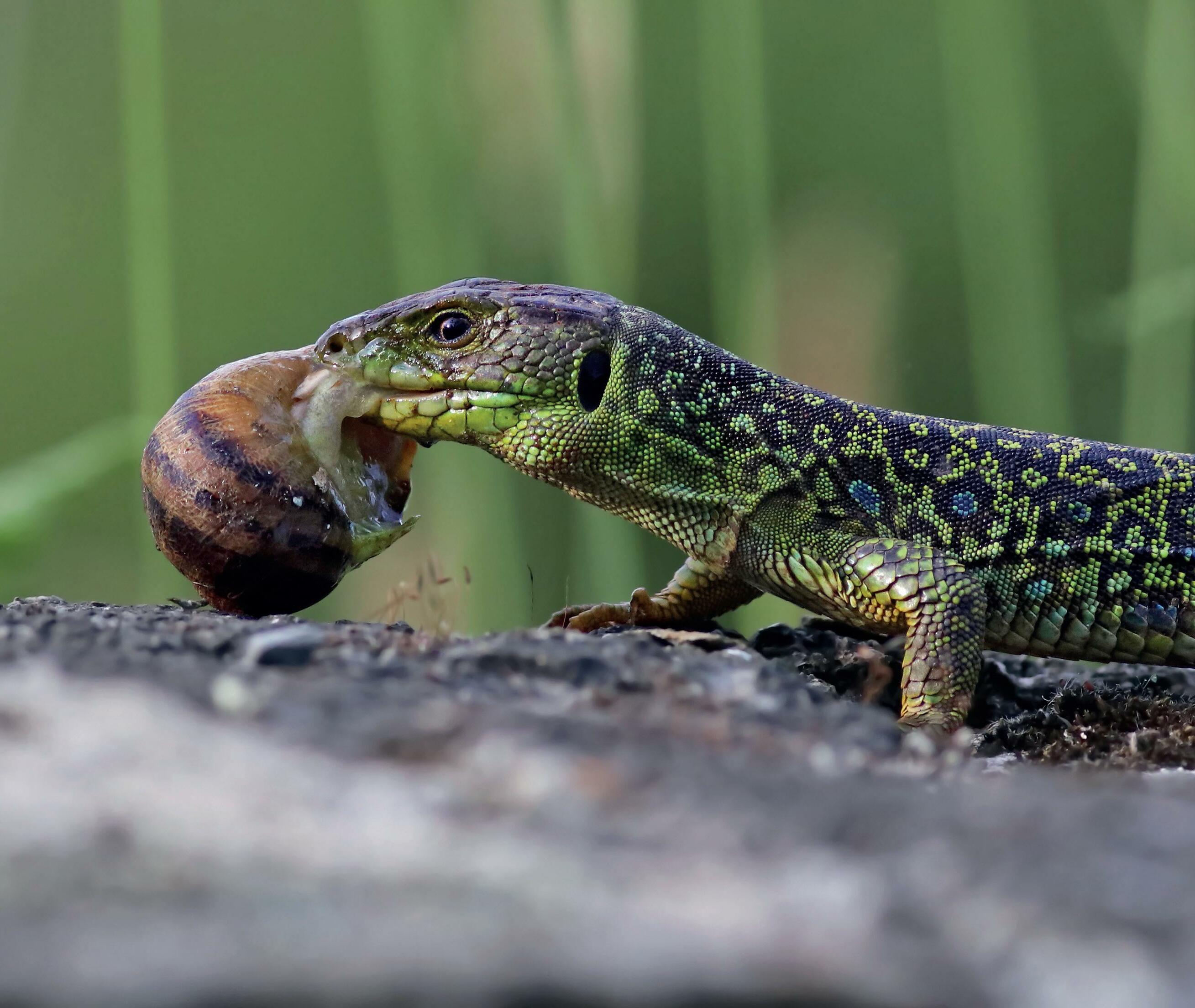
19 SEPTEMBER 2022
European eyed lizard (Timon lepidus) feeds on snail








Earthworms

(Dendrobaena sp.)
Sometimes referred to by its much more menacing US name the “nightcrawler”, the earthworms sold in the UK are European species very similar to the ones found in our gardens after it has been raining. They are commonly used as fishing tackle and make a juicy treat for toads, salamanders, skinks and other temperate, terrestrial reptiles and amphibians. They are great for freshwater species including turtles and large fish. Most birds will also love an earthworm, but as they are sensitive to light and surprisingly adept climbers, might be better suited to a contained environment or a specially designed feeder dish.
Increasing numbers of hobbyists are also using nightcrawlers as clean-up crew for their bioactive enclosures. In some ways, nightcrawlers might be too efficient for most bioactive setups. However, very large enclosures (especially for arboreal animals) with several layers of leaflitter are ideal for a few nightcrawlers to be introduced.
Nightcrawlers have a surprisingly commendable nutrient profile. Their calcium to phosphorous ratio is 1.5:1 which means they don’t require additional supplements. However, they are mostly moisture, so although they don’t have much phosphorous, they are not exactly calcium-rich either. Nonetheless, their moisture content makes them perfect for hydrating exotic animals and can provide enrichment in the form of unique textures and scents. Nightcrawlers should be bought from a specialist reptile shop, rather than a fishing store. Worms raised as bait are unlikely to be fed the same quality ingredients as commercially-bred live food and could potentially be exposed to harmful components.
Nightcrawlers can be kept and stored for a long time, but the keeper should provide insect food and fresh vegetables to ensure they are gut-loaded before feeding. Many keepers will acquire several tubs, or a bulk bag of the worms and create a ‘wormery’ to store and breed the nightcrawlers. Providing that the correct temperatures are met, this can be a good waste-disposal technique that will result in some exceptionally fertile soil.
21 SEPTEMBER 2022
The New Bugs on the Block
Earthworm (Dendrobaena sp.)
Large-sized prey
Centipedes
(Scolopendra subspinipes)

Centipedes are a niche feeder insect but are now widely available as ‘eco-fresh’. There are certain species of snake which will only feed on centipedes and although they are not frequently kept as pets, the introduction of centipedes to UK stores may prompt a lot of exciting advancements in herpetoculture. Furthermore, the keeper can safely provide a natural diet. Centipedes play a particularly important role as a feeder insect for predatory birds and exotic mammals, such as meerkats, mongooses and fennec foxes which would actively prey on these largerbodied insects in preference to crickets or mealworms. Their nutrient content is not exceptional, but the variety they provide is. Centipedes have a rough nutritional composition of: protein 24%, fat 4%, fibre 3%, moisture 67%, calcium 0.1%, phosphorous 0.5%. The ProBugs centipedes that are regularly available in the UK belong to the S. subspinipes species (which is often considered a ‘complex’ due to its subspecies diversity). These centipedes are found throughout South and Southeast Asia. Therefore, they provide a perfectly natural treat for Chinese water dragons (Physignathus cocincinus), tree and juvenile water monitors (Varanus spp.), tarantulas
(Poecilotheria spp.) and large-bodied geckos such as tokay geckos (Gekko gecko).
Scorpions
(Olivierus martensii)
Scorpions may be considered a ‘novelty’ treat for reptiles, but they also contain a great nutrient profile. Their perfect calcium to phosphorous ratio means that they can be fed with no additional supplements. The ones available in the UK come via ProBugs and are preserved to save these nutrients as opposed to dried/canned products which are popular in the US.
Many popular reptiles would naturally predate upon scorpions. From leopard geckos (Eublepharis macularius) to bosc monitors (Varanus exanthematicus), many wild lizards will risk potentially dangerous encounters to secure a hearty scorpion meal. The nutritional composition of scorpions makes them appealing to a wide range of animals including larger tarantulas. The ones available on the UK market are ‘Chinese armour-tail scorpions’ which are naturally found in northern China, Mongolia and Korea. However, they do belong to the Buthidae family – the most widespread family of scorpions on the planet and are an excellent model species to feed to a variety of animals.

22 SEPTEMBER 2022
Scorpion (Olivierus martensii) being eaten
Centipede (Scolopendra subspinipes)
They consist of 25% protein, 10% fat, 6% fibre and 60% moisture. They also have a calcium to phosphorous ratio of 1:1 This perfect ratio, combined with a healthy dose of moisture makes scorpions much more impressive than a novelty item. Unfortunately, the resources involved in raising scorpions as a commercial feeder have meant they are one of the more expensive prey items. On the other hand, the preservation technique used by ProBugs gives them an extremely long shelf life. This gives the keeper flexibility to purchase the items and keep them stored for both emergencies and occasional treats.
Dubia roaches

(Blaptica
Dubia roaches are quickly becoming one of the most popular feeder insects on the market. Now available in a range of sizes, they are perfect for large lizards such as adult bearded dragons, monitor lizards and tegus. Although ‘dubia’ are most popular, there are a few different species out there. Roaches will live for much longer than other live foods, meaning a keeper can experiment with a few different sizes and irregular feeding without wasting any. They are also ideal for a keeper who is planning to go on holiday and needs to leave a spare pack of bugs ready for when they return.
Roaches can be gut-loaded on professional formulas, or with vitamin-coated veggies. It is no secret that roaches can survive very harsh conditions. This is partly because they have long digestive tracts and can survive over three days without food, meaning a well gut-loaded roach could contain 3X the goodness of another seemingly healthy roach. Dubia roaches also contain almost double the amount of protein of other popular feeder insects and near-perfect calcium to phosphorous ratio. They are not as widely available as crickets and locusts, but can be found online and in specialist shops, then stored in a plastic tub, faunarium or ‘cricket keeper’ until they are used.
Giant lobworms
(Lumbricus sp.)
Giant lobworms do all the things that nightcrawlers do but on a larger scale. A decent nutrient profile packed full of moisture and easy to maintain and breed. They are excellent for blue-tongued skinks (Tiliqua spp.), salamanders, horned/pixie frogs and adult turtles. New Caledonia giant geckos (Rhacodactylus leachianus) also seem to love these worms, despite them being farremoved from their natural diet. Arowana, Oscars and other very large tropical fish will also gorge themselves on these molluscs in impressive feeding frenzies.

23 SEPTEMBER 2022 The New Bugs on the Block
dubia)
Giant lobworm (Lumbricus sp.)
Dubia roach (Blaptica dubia)
SNAKES AND ADDERS
The new threats facing the UK’s most iconic snake.
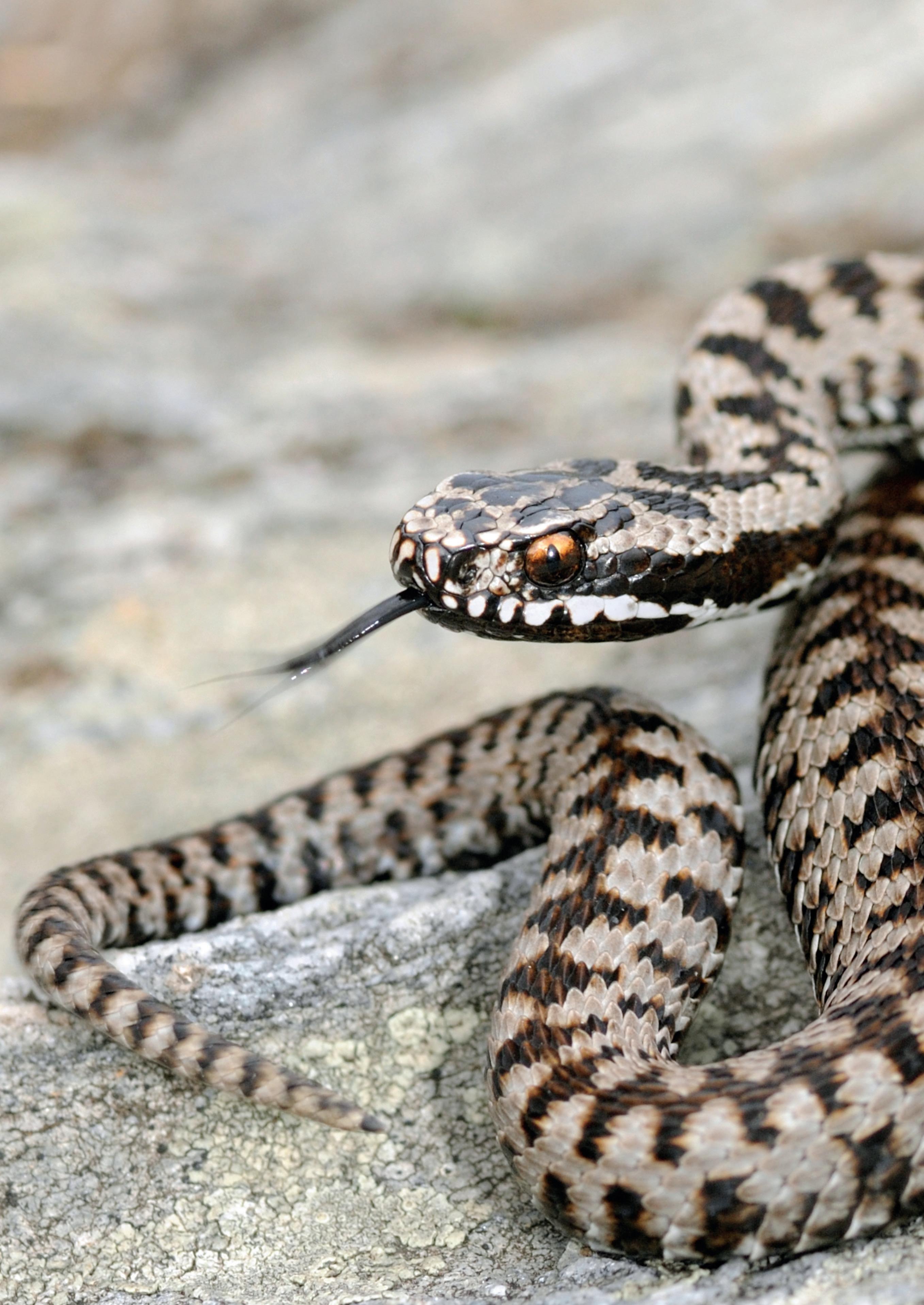 Male Common European Adder (Vipera berus)
Male Common European Adder (Vipera berus)

The UK’s only venomous snake, the adder (Vipera berus) has seen continuous population declines for decades. Despite being an iconic and once widespread species, a mix of habitat destruction, humananimal conflict and wildfires have decimated populations, resulting in county-wide extinctions.
The adder
The adder is one of the UK’s six native terrestrial reptile species. It is a shy and secretive snake that inhabits heathlands, woodland edges and open forested areas across most of the UK. Beyond Britain, the adder is one of the most widespread species of reptile on the planet. Vipera berus (or one of its five subspecies) can be found across Europe and Asia as far East as North Korea. Originally described by Karl Linnaeus in 1758, the European adder is an easily identifiable and sexually dimorphic species. Females grow up to around 70cm and are brownish with a dark brown zigzag pattern down their dorsum. Males are slightly smaller, much lighter in colouration (sometimes even appearing grey/white) and far more contrasted. In most cases, their zigzag pattern is an obvious black. Across their entire distribution, population numbers are declining. Here in the UK, habitat fragmentation is the driving force in this decimation.
Rob Free is the Weald Reserves Manager for Amphibian
and Reptile Conservation (ARC). He maintains most of the ARC sites in Surrey, Hampshire and Sussex. Rob told Exotics Keeper Magazine: “The main threats facing adder populations is that heathlands are all little pockets of protected habitats. These are surrounded by roads, farming and agriculture so they can’t move around and intermix very easily. This could potentially cause problems with inbreeding if populations are very small on a site. Of course, if something catastrophic happens - like a wildfire on a heathland - then they’re wiped out. Animals that do survive don’t have any cover and are quickly picked off by predators.”
“Adder populations are declining pretty much across the country, particularly in regions North of the Thames. In these areas, people are reporting much smaller adult snakes and fewer juveniles. Some counties have lost them as a breeding species already. In Surrey, we do have quite good numbers on heathlands, but not as many as in the old days. In Victorian times, snake catchers have recorded removing
26 SEPTEMBER 2022 Snakes and Adders
hundreds per acre. We’re within the tens, now, which is a huge decline but better than many areas in the country.”
Despite significant threats from humans, adders are surprisingly hardy snakes. They can tolerate a range of environments and appear to thrive in cooler conditions when compared to other reptile species.

John Gaughan, Weald Field Officer for ARC added: “They come out of hibernation around March/April, so they’re a very cold-tolerant snake. They have a huge distribution across Asia and into Scotland. They also have an arctic range and can be found in Scandinavia. Interestingly, you can find them on the edge of snow at the end of winter. At
times when it has snowed into March, there’s still going to be some level of activity and they will pop their head out from hibernacula. In fact, they’re less tolerant of heat. As you move further south into warmer parts of Europe, the adder is replaced by its close relative the Asp viper (Vipera aspis). In these areas, adders tend to occupy mountainous regions in the cooler climbs of the alps.” The European adder can be found at altitudes up to 3000m. Whilst that is not uncommon for Viperid’s, particularly those from neotropical cloud forests, in Europe these are often alpine or subalpine environments.
Males tend to leave their hibernacula first, at the beginning of spring. In
cooler climates, it can take between two and three weeks for the males to thermoregulate enough to complete spermatogenesis and thus become ready to mate. Females will often only mate every two to three years to allow them to accumulate enough fat and energy to reproduce successfully in these harsh environments. As an ovoviviparous species, the females must be extremely healthy to produce viable eggs which hatch within the body. Mating begins in late spring and young are birthed in late summer, meaning a successful birth is crucial to the survival of the female which will need to build up fat and energy reserves, ready to brumate in September/October.
27 SEPTEMBER 2022
and Adders
Snakes
Female Common European Adder (Vipera berus)
Isolated populations of adders also tend to exhibit morphological differences. “Any black snake found in the countryside is likely to be an adder also as there are quite a lot of melanistic animals” added John. Whilst there is still a lot of research going into understanding why this is, the consensus is that habitat fragmentation is decimating the available gene pools for these animals. Therefore, darker individuals are produced more frequently. The darker animals also have a slight ecological advantage, as they can warm up quicker than lighter snakes – allowing them to emerge from hibernation sooner and giving them a daily advantage when it comes to hunting. It could be that these darker animals also camouflage from predators such as buzzards, slightly better than the nominate morphs.
Wildfires
Adders are facing a multitude of threats, some of which are entirely preventable. Globally, instances of uncontrolled wildfires are increasing. In fact, 2021 saw some of the most destructive wildfires on record. Although these terrifying news reports may seem to be focused on faraway, exotic locations, wildfires pose a significant threat to the UK’s heathlands. Rob continued: “We had a fire on one of our Chobham Common sites two years ago that took out a good third of the reserve. I suppose with drier weather the heather, in particular, becomes very flammable and can easily combust if there’s a discarded match or cigarette. Reptiles require lots of dense cover, so they prefer heather that is quite tall. It can take a very long time for heather to reach that stage. We had
a fire on Ash Ranges and Gong Hill a few years ago, following a dry spring. We do hear that some people will take portable BBQs which is not the right thing to do on a nature reserve and can certainly lead to wildfires.”
John added: “Fires are not good generally. I know there are controlled burnings happening already up north for grouse, but these can really affect reptiles as they have a poor ability to disperse. Once the fire has gone through, the animals emerge and there’s no vegetation, no cover, no moisture and they’re at the mercy of increasing predators. We’re seeing increased numbers of buzzards (Buteo buteo) further south now. Here in Hampshire, we haven’t been hit as heavily as Dorset, but arson is also a serious risk in more urbanised areas.”

28 SEPTEMBER 2022
Burning of a heathland habitat
more volatile locations such as Northern Australia or the West Coast of the USA, are important in maintaining certain habitats. However, these are executed by professionals and supported with ecological data and justifications. In the UK, heathland is often small and fragmented, making it an extremely fragile ecosystem. Rob explained: “Heather does regenerate, it is quite resistant to fire. It has probably adapted to it. They will regrow from seedlings or stumps if it hasn’t been too burnt too severely. It will take a few years to regrow though. It cycles through juvenile heather, which is very short to mature and degenerate which can take 20+ years sometimes.”
When this happens we will get a burst of short-growth which is important for invertebrates out here” added John “For example, the silver-studded blue butterfly needs that new growth. In fact, there are parts of the reserve that are maintained at short growth year-round, to support this highly localised butterfly species.”
Human/animal conflict is also a considerable threat to adder populations. Their fearsome reputation as the UK’s only ‘venomous’ snake means that conservation efforts can sometimes prove futile in the face of public consensus. ARC research suggests that between 50 to 100 people are bitten by adders each year, the majority of which have occurred due to deliberate manipulation of the animal. There has not been a death from snake bites in the UK since 1975. In the 100 years before this (a time when there was very little understanding on how to even treat a snake bite) only 14 people had ever been killed by adders. On the contrary, thousands of adders are likely killed by people either deliberately or through habitat degradation
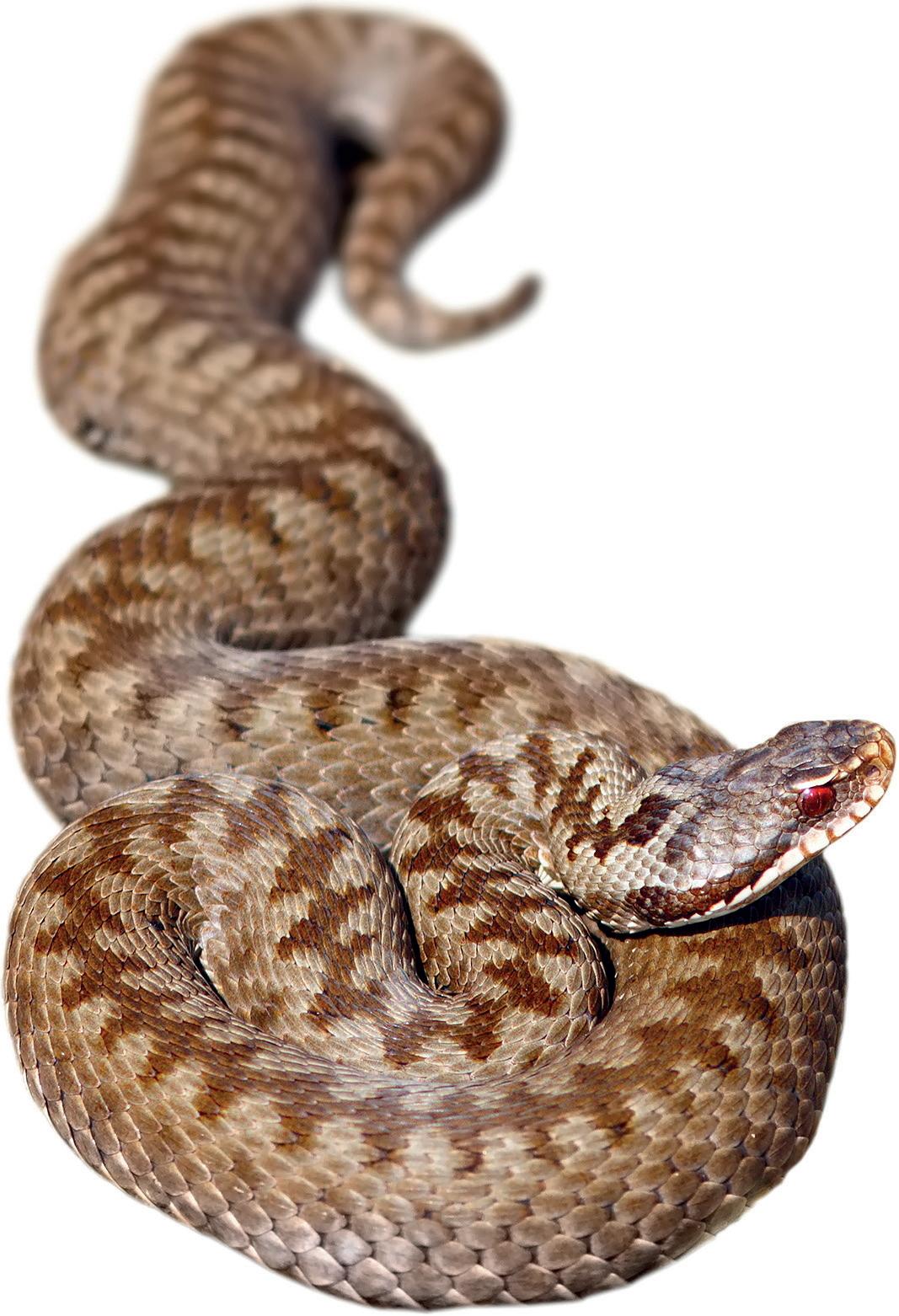
“Adders are venomous, so yes, they are a risk. I’ve heard of people trying to photograph animals, getting too close and getting bitten which is perhaps their own fault. It is important that people keep their distance and don’t disturb these animals too much. More frequently I’ve heard of dogs getting bitten. This can be prevented by sticking to the paths and keeping dogs on leads. It will also stop the dogs from disturbing important breeding behaviours.” Every year, at least one dog is killed by an adder after being bitten. Whilst this is heartbreaking for the owner, over 100 bites on dogs are reported each year. Most of these dogs are treated with antihistamines and after feeling unwell for a day or two, recover fully. Although dogs should be always kept on leads in heaths and downs, media scaremongering is undoubtedly having a greater impact on adders than adders are having on the UK’s pets.
Amphibian and Reptile Conservation Trust
ARC UK is an organisation dedicated to preserving the UK’s native reptile and amphibian species. Although there are numerous organisations across the country that allow volunteers to support conservation initiatives, ARC maintains over 80 sites of significant interest across the country on a full-time basis, covering over 2000 hectares. As well as educational outreach programmes, the organisation does lots of boots-on-the-ground
29 SEPTEMBER 2022 Snakes and Adders
conservation work. John explained: “We work to maintain and look after Britain’s reptiles and amphibians. One of the key things we do is maintain sand to allow sand lizards to lay their eggs. It’s simple, there’s sand here already, but we use trimmers and equipment to strip it down to the bare sand. Naturally, this would be done by badgers and foxes, but their numbers have decreased on our heathlands, so we need to get the sand up to the surface for the lizards. Usually, every three years we need to re-rotate the sand.”
ARC also lay survey tins down across their sites. Corrugated iron makes for excellent refugia and by conducting regular surveys of these tins, the team can
roughly monitor the population numbers across the area. These refugia attract slow worms (Anguis fragilis) and on some sites, smooth snakes (Coronella austriaca) and sand lizards (Lacerta agilis) also. Often these sites are on public land, but the organisation has a license to manage those areas. Therefore, it is vitally important that members of the public do not disturb the refugia (which is considered illegal on sites that contain smooth snakes).
Those that do wish to see the UK’s reptiles and amphibians out in the wild, should consider volunteering with a local ARG (amphibian and reptile group). For more information on Amphibian and Reptile Conservation please visit www.arc-trust.org.


30 SEPTEMBER 2022 Snakes and Adders
Scan the QR code to watch our interview with Owain of Amphibian and Reptile Conservation.
Melanistic Common European Adder (Vipera berus)
PRODUCTS


“Head and shoulders above the rest”
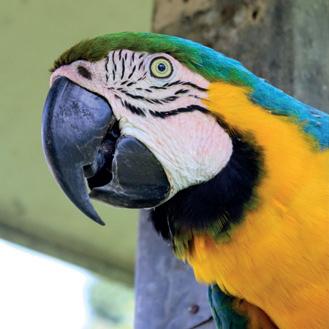





Highly safe and effective disinfectants and treatment products for optimal hygiene and infection control. F10 has the product for your health and hygiene needs. f10products.co.uk



















SEPTEMBER 2022
WHEN LIFE GIVES YOU LEHMANN’S…
Discussing the care and keeping of Oophaga lehmanni with Ross Dacre
 Lehmann’s poison frog “orange” (Oophaga lehmanni)
Lehmann’s poison frog “orange” (Oophaga lehmanni)
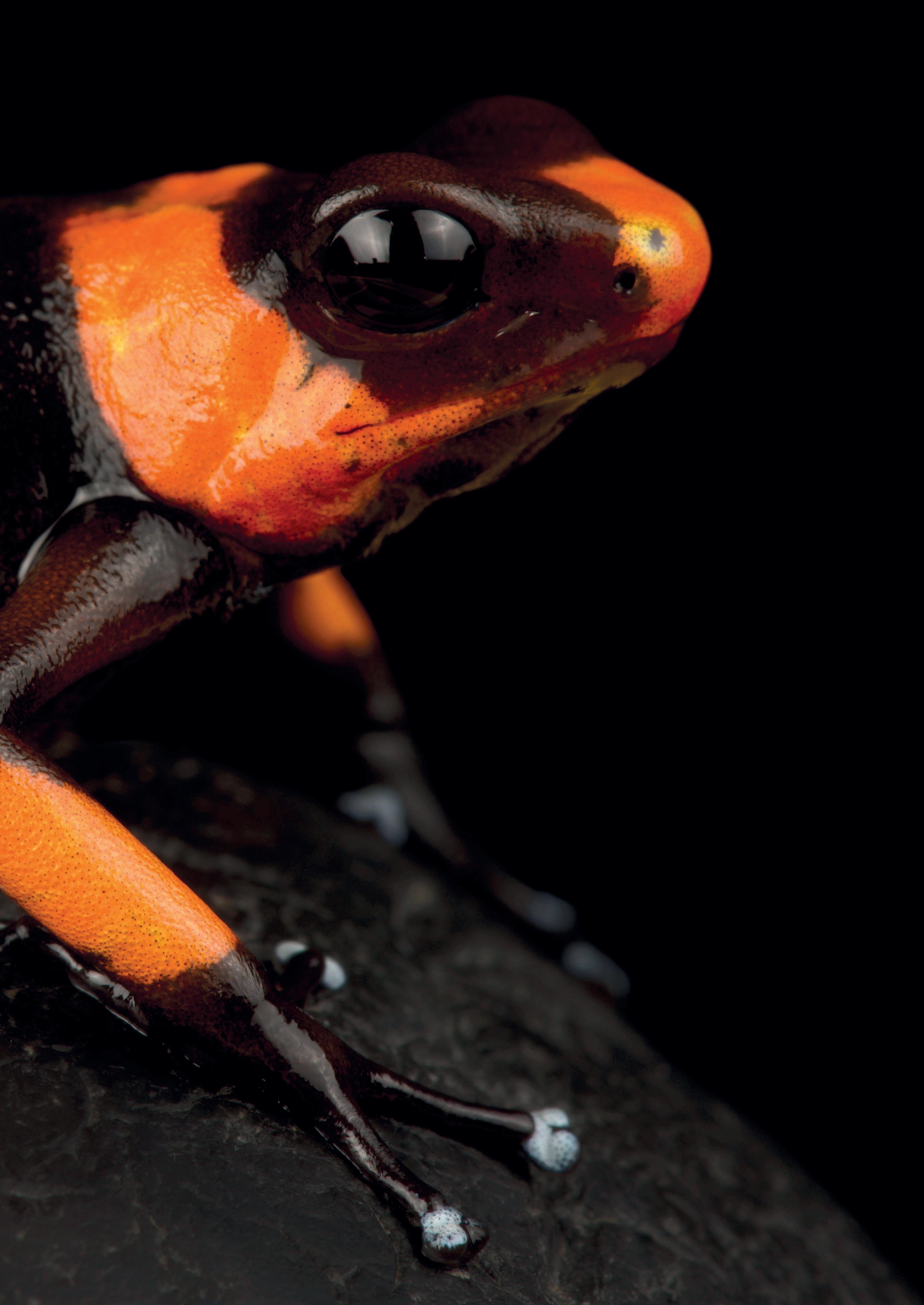
Lehmann’s poison frog (Oophaga lehmanni) is a critically endangered species of Dendrobatidae endemic to the Valle de Cauca, Colombia. There are several populations of this species, but their total distribution ranges no more than 10km2. This means the species is extremely vulnerable to deforestation and sustainable captive breeding may provide a final lifeline. To support global breeding projects, an organisation called ‘Tesoros de Colombia’ began producing large numbers of rare Colombian Dendrobatids in-situ and legally distributing captive-bred animals across the world. Now, keepers in the UK are beginning to establish healthy breeding colonies, driving down the demand for poached specimens and improving our understanding of these unique frogs.
Oophaga
Ross Dacre is a herpetoculturist with a fascination for poison frogs and has been keeping and breeding Dendrobatids for over 12 years. Recently, he successfully bred the yellow locality of the Lehmann’s poison frog, in what is thought to be a UK first. Ross told Exotics Keeper Magazine: “Oophaga lehmanni is a relatively large frog in the Dendrobatid world, with adults reaching approximately 3 and a half centimetres from snout to vent. These unique frogs have little to concern them in the wild due to their toxicity and aposematic colouration, warning any would-be predator of their unpalatable nature. Their colouration and, to an extent, pattern vary depending on their locality in the wild. Separate locales of red, yellow, and orange all with a base colour of brown to black banding can be found, with their white toe tips glistening amongst the leaves.”
The rainforests of Colombia host many different species of poison frogs, including seven distinct species from the Oophaga genus. These animals are extremely diverse in their colouration and some species have only been described within the last 50 years. One of these is the Anchicaya poison frog (Oophaga anchicayensis) which was only described in 2018. Ross continued: “Oophaga lehmanni and Oophaga histrionica are parapatric species and where contact areas occur in the wild interbreeding between the two happens. One such area is the San José de Anchicayá area where in 2018 a known mix between yellow O. lehmanni and O. histrionica was recognised as Oophaga anchicayensis. ”
Although Lehmann’s poison frog is critically endangered,
34 SEPTEMBER 2022 When Life Gives You Lehmann’s…
there has been some support for the species, which came into fruition before scientists knew of its existence. Ross continued: “On July 15th, 1968, Parque Nacional Natural Farallones de Cali was established protecting Valle de Cauca with great influence from acclaimed biologist and conservationist Federico Carlos Lehmann Valencia. It is in this biologically diverse area where all populations of O. lehmanni can be found. When describing O. lehmanni in 1976, Myers and Daly recognised the importance of such work and aptly named the red-banded frog Dendrobates lehmanni (which was later changed to Oophaga lehmanni in 2006).”
Treasures of Colombia
As a protected species, it is illegal to harvest individuals from the wild. In some cases, this can increase demand for a species, which is exactly what Tesoros de Colombia is aiming to combat. Labelled a ‘sustainable farm’, the organisation has received official licensing from the Colombian government to keep and breed several of the country’s most endangered amphibians for export. Working with conservationists, ecologists and environmental engineers, “Tesoros” can satisfy some global demand whilst having a minor impact on wild populations. Expert breeders such as Ross can source a
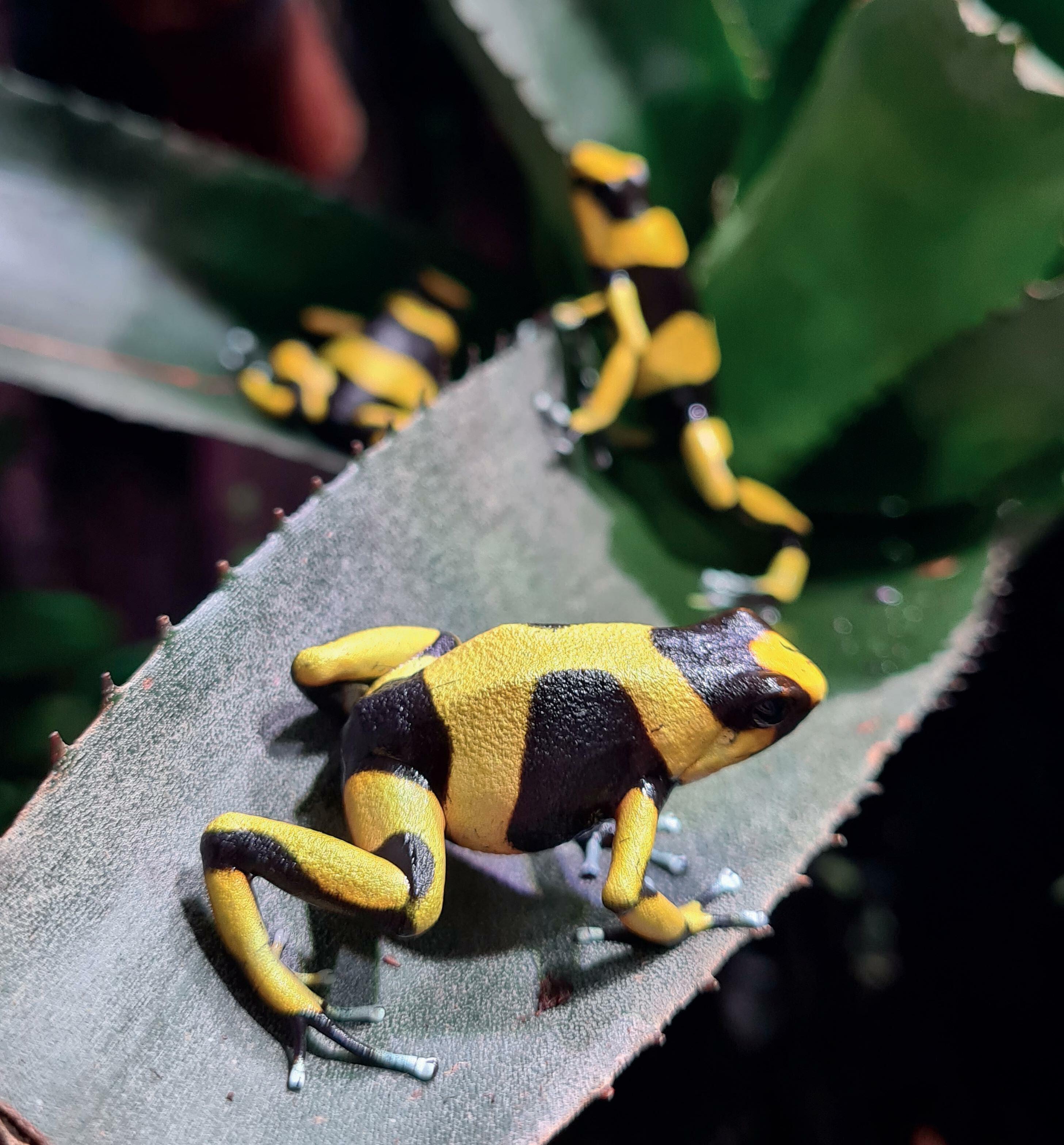
35 SEPTEMBER 2022
A trio of Lehmann’s poison frog “yellow” (Oophaga lehmanni)
viable pair (or group) and begin to breed good numbers of the species internationally. This not only creates a large captive population for ex-situ research but also drives global demand for wild-caught specimens down.
“I have been following the work of Tesoros De Colombia with a keen interest for many years, long before they had even exported frogs out of Colombia” added Ross. “The concept of conservation through commerce appeals to both my passion for Dendrobatidae as a hobbyist but also my respect for the need for in situ projects to ensure that captivity isn’t the only place in which future generations can enjoy these amazing creatures.”
The popularity of keeping poison frogs has increased drastically in recent decades. Although poison frogs have been kept by hobbyists since the 1980s, product development spurred by the ‘bioactive boom’ has made this much more accessible. Now, it is much easier to create a fully natural replica of the South American rainforest and thus, keepers are having much more success in keeping and breeding rare frogs. Most Dendrobatids are listed under CITES Appendix 2 which restricts trade, meaning wild-caught specimens are illegal and even captive-bred animals can be difficult to source.
Ross continued: “For the entirety of my time keeping dart frogs, it has seemed just a pipe dream to have
captive-bred, ethically sourced large Oophaga from the likes of Tesoros De Colombia directly imported into the UK. To put it into perspective, I needed to travel to Holland to purchase my Phyllobates aurotaenia ‘yellow’ that are of Tesoros De Colombia origins. Then to Germany to obtain orange Phyllobates terribilis ‘blackfoot’ too but the only time I had ever seen any Oophaga from Tesoros in the flesh was at the American Frog Day 2019 and even then, I wasn’t able to acquire any. When I was contacted by Fantastic Frogs and told that they were planning the first ever shipment into the UK I jumped at the opportunity. I was then sent an availability list that consisted of dream frog after dream frog but decided on O. lehmanni ‘yellow’ based on the opportunity to support in situ conservation of a critically endangered species whilst also working towards establishing a captive population here in the UK being in my opinion, a worthy cause. I’m under no illusions that the likelihood of my frogs being reintroduced into the wild is none to zero, but I am a believer in conservation through commerce and by supporting such projects we can all benefit species long term.”
Breeding poison frogs
Given the correct conditions, many species of poison frog will breed readily in captivity. Oophaga lehmanni exhibit remarkable parental behaviours. Once the tadpoles have emerged from their eggs, which are laid on land,
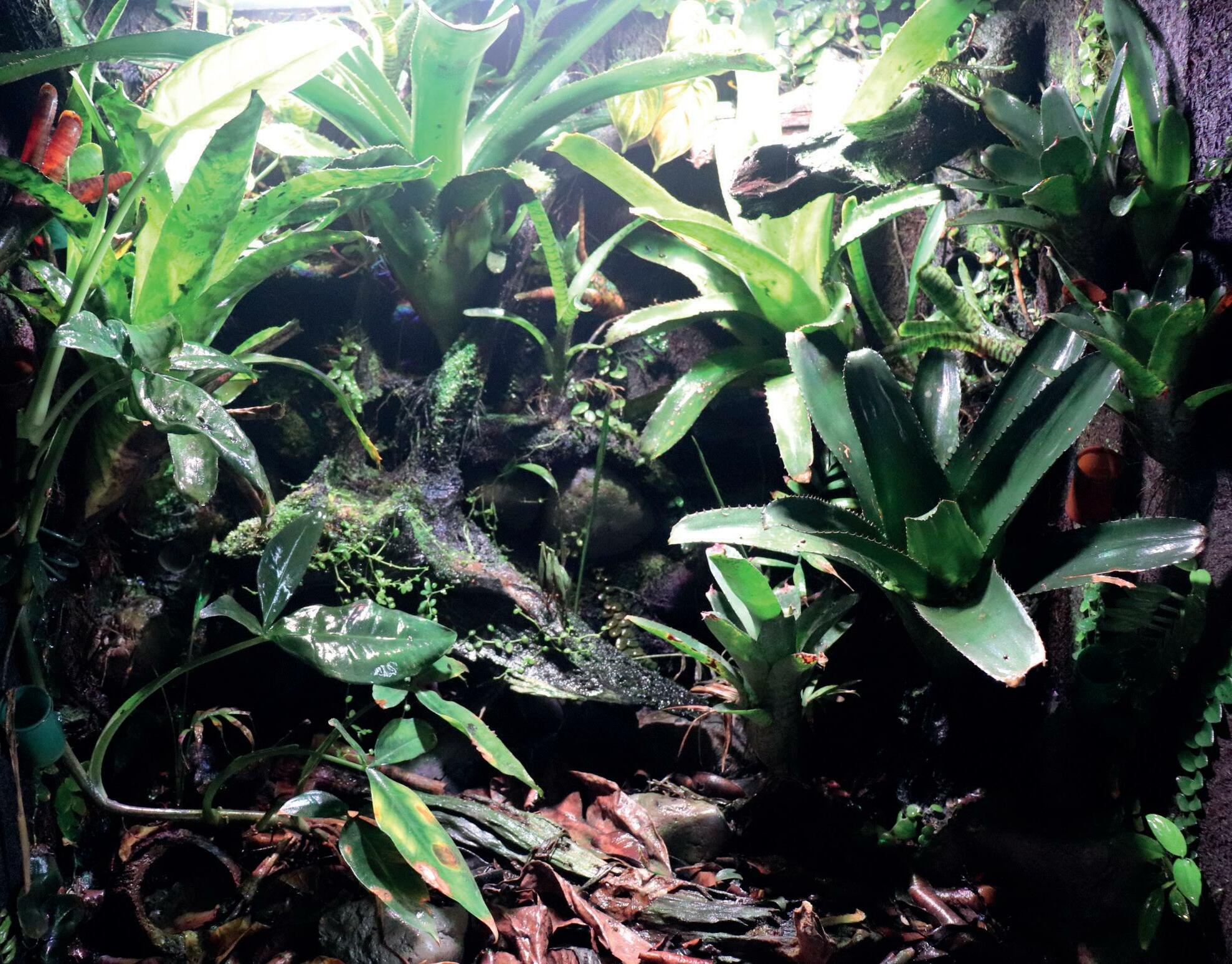
36 SEPTEMBER 2022
Ross’ Oophaga lehmanni enclosure
the parent female will transport each tadpole individually by carrying them on her back to separate water sources (most often bromeliad axils) which can be several meters up within trees. This is no mean feat for a frog that is less than one and a half inches in size. The parent female must then remember where she has placed each tadpole and return periodically to feed them to have any chance of their survival. “When broken down and translated from Greek, Oophaga (oon, phagos) means ‘egg-eater’” Ross added “This is the name given to this genus of frogs due to the fact tadpoles within the genus are reliant on the trophic eggs from their mother for successful metamorphosis.”
“Although some success has been achieved in captivity with raising Oophaga tadpoles on both trophic eggs as well as eggs laid on land for reproduction purposes by both the parent species, as well as on other Oophaga species eggs, it has always been my intention to design a vivarium in which the whole process from egg to froglet would occur without the need for any intervention. I decided to choose bromeliads with broad, sturdy leaves to support the weight of the frogs yet also hold a large body of water in their axils such as Aechmea cucullata for breeding purposes. I only added smaller bromeliads as aesthetic accents, to create visual barriers and to make better use of the available space within the vivarium. I also added artificial tadpole deposit sites in the form of film canisters angled to constantly hold water. This meant I was able to watch the daily progress of the tadpole as it was unable to adequately hide from view unlike its siblings within bromeliad axils.”


Setting up the ideal enclosure does not guarantee tadpoles, let alone froglets. One of the major challenges for frog breeders is sexing the animals, particularly if the froglets are sourced at a young age. Across most species, these are extremely difficult to sex. However, if a viable pair are housed together it can lead to some insightful observations. Although breeding behaviours have been widely documented in other Oophaga species, making notes on the behavioural cues of the critically endangered Lehmann’s poison frog

SEPTEMBER 2022
A tadpole with trophic eggs
A female O. lehmanni laying eggs
Juvenile O. lehmanni ‘froglets’
has developed Ross’ knowledge and with a sustainable captive-bred population now available in the UK, could improve wider understanding of the species.
Ross continued: “One observation that I hadn’t previously witnessed in approximately 12 years of keeping Dendrobatidae was the courting process as a whole, from calling to the laying of eggs. I was sitting watching the male calling toward what was an unsexed frog at the time, trying to judge the other frog’s reaction to help gauge its sex. Then the known male started to exhibit behaviour I hadn’t seen before, it stopped moving as it was previously stepping away from the other frog and started stamping its front foot on the bromeliad leaf, in what I can only describe as if he were saying “here is the spot”. The unsexed frog moved towards the male and began to move its back legs in a swiping motion, the movement was similar to a kick but the motion was as if it was trying to clear and or clean the surface of the leaf where the male had been stamping. The female was circling on the spot whilst doing this, often in a submissive posture. Then to my excitement, the two frogs positioned themselves vent to vent in independent amplexus and the unsexed frog began to lay eggs!”
Sustainable sourcing
Sustainability is a popular concept for many industries in 2022. Unfortunately, the unsustainable practices of deforestation and agriculture rarely make consideration for the delicate fauna they threaten. Nonetheless, exotics keepers should be extra vigilant when it comes to sourcing animals. Pet keepers who have no intention of breeding their animals should always source captive-bred specimens. Breeders may require wild-caught animals to diversify their bloodlines, but where possible, captivebred specimens should always be prioritised. In the case of critically endangered species, sourcing animals from a respected breeding facility can ensure that sustainability is put at the forefront of the breeding initiative.
“When making the reservation for my frogs, I purchased them as a group of 4 unsexed juveniles in the hope I would be lucky enough to end up with at least one pair” explains Ross . “However, due to the bureaucracy involved with importing species from Colombia, not least for the first time into the country, the timescale involved was long enough for my frogs to arrive with me knowing that I had at least one female, as it had laid eggs shortly

38 SEPTEMBER 2022 When Life Gives You Lehmann’s…
A male O. lehmanni calling for a mate
before shipping. After arriving home, I heard calling from the vivarium. Which, to my delight, meant I had at least one pair. I have since proven out the known female too as I have witnessed her carrying tadpoles as well as feeding trophic eggs to them once deposited in water and I have also witnessed another frog lay eggs on land. So, I know with certainty I have a ratio of 1.2.1” (1 male, 2 females, 1 unsexed).
Ross is hoping to keep his juvenile frogs until they can be sexed. Most poison frogs take upwards of one year before the keeper can make an informed decision on the sex of the animal. By identifying the mother frog and holding back the froglets, he will eventually be able to pair the youngsters with a genetically viable partner. Once Ross has secured 2 breeding pairs, it is likely that O. Lehmanni ‘yellow’ will become more available in the hobby over the coming years. Ross added: “when the original 4 arrived on these shores, there were more pandas in the UK than there were Oophaga lehmanni ‘yellow’ and if I was to lose my only known male then any hope for establishing them within the UK would ride solely on one of my current offspring being a male.”
“In 2022, many species of amphibians are facing the very real threat of extinction. This is caused by issues such as climate change, habitat destruction and disease, which means that any decision that we make as hobbyists going forward must always put sustainability at the forefront of our minds. This is not limited to sourcing animals but goes right through to husbandry practices from using more energy efficient lighting to re-using and recycling live food culturing equipment.” – Ross Dacre, Experienced Poison Frog Breeder

39 SEPTEMBER 2022
When Life Gives You Lehmann’s…
One of ross’ frogs in the enclosure
DRY FOODS, FORMULAS & SUPPLEMENTS







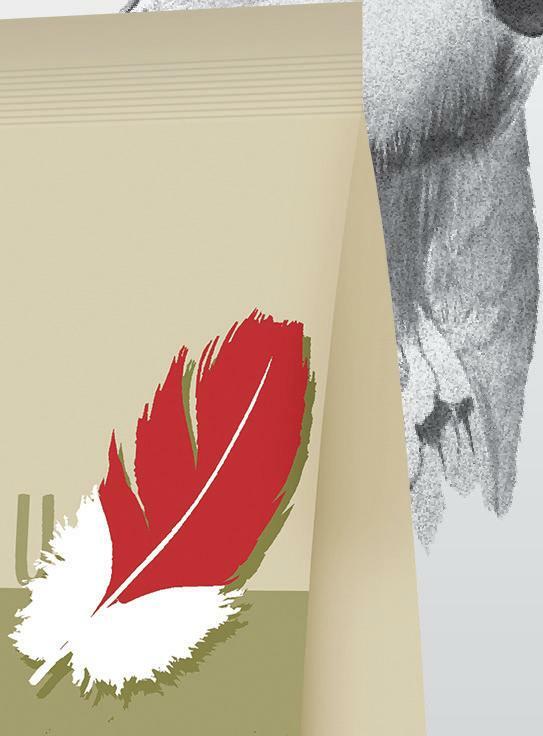


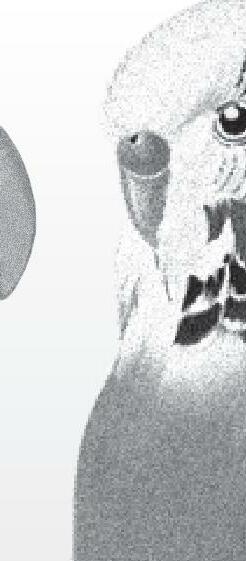







Ideal for species which, in the wild, consume a significant amount of fruits and seeds from oleaginous plants (genera Psittacus, Ara, Poicephalus).



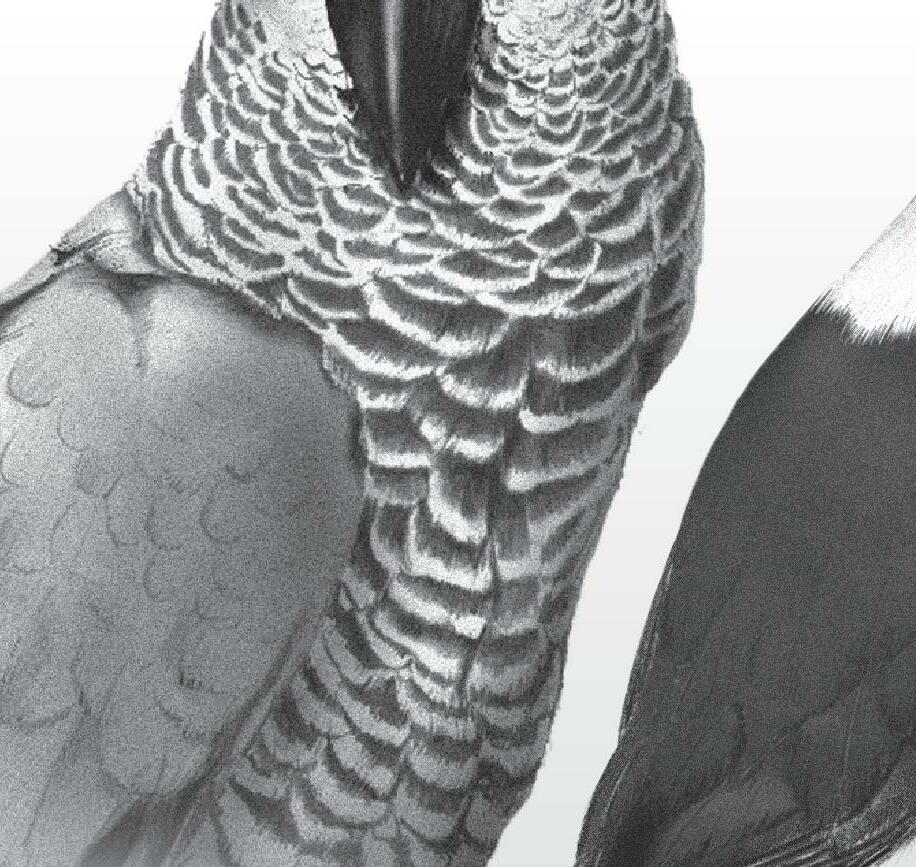



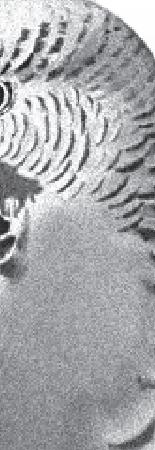
Available in 800g, 3Kg and 12Kg bags






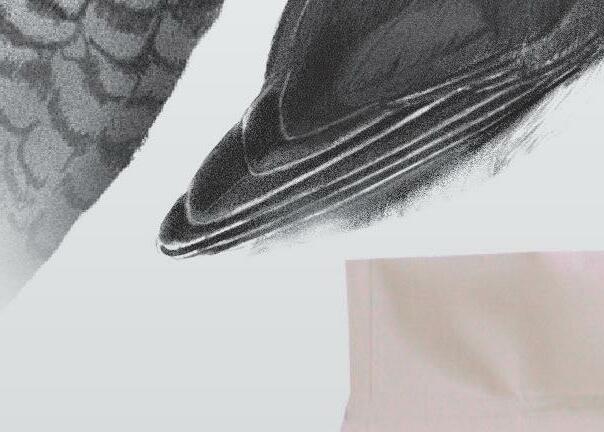




40 SEPTEMBER 2022
High Energy
KEEPER BASICS: PARROT PROBLEMS
 African grey (Psittacus sp.)
African grey (Psittacus sp.)
It is not always easy to tell when a parrot is ‘sick’. Some key characteristics of a sick parrot include subdued behaviour, assuming a ‘fluffed up’ posture and a loss of appetite. Droppings can also be a good indicator of parrot health and keepers should speak to a vet if they notice anything consistently unusual. Other illnesses can build up over time and present very different symptoms. Whilst the majority of these issues are rooted in subpar husbandry, it is important to understand the cause and potential cure of some of the more common pet parrot ailments.
Deficiencies
The most common health problems encountered by parrots in captivity are rooted in deficiencies. It took many decades for reptile keepers to gain a strong grasp on supplementation and UV requirements. During the same time, aviculturists have been developing various supplements and foods to counter the most prolific ailments in parrots. The most common deficiencies are that of vitamin-A and calcium which are only found in small quantities in most seed-based ‘parrot mix’. If a bird has been fed this diet for its entire life, it will almost certainly face one of the following health problems:
Hypovitaminosis-A can cause lasting damage to the lining membranes of the mouth, throat and nose. Eventually, it can cause kidney damage and infections. Often, this disease presents with symptoms in enough time for the keeper to supplement their bird with lots of Vitamin-A and improve their bird’s diet.
Hypocalcaemia is a broad illness that presents in lots of different ways, with several parallels to reptiles. Breeding
parrots may become egg-bound, have soft eggs, or lay no eggs at all. Growing chicks can develop rickets and have poor bone quality. Adult birds may also suffer from weakness, tremors, and fits. They may also fall from their perch, causing trauma to the face and claws. This problem is most severe in African grey (Psittacus sp.) and Eclectus (Eclectus sp.) parrots which require a much higher calcium provision.
Obesity
Although too little of a good thing can cause problems, so can too much. Obesity is a common health issue in many smaller parrots including budgerigars ( ) and roseate parrots ( ). Although it is not always easy to spot a fat parrot, keepers must be vigilant with how much food they are providing. Excessive amounts to fuel the parrot’s fussy eating habits will most likely lead to an obese bird. In extreme cases, yellow fat deposits can be seen beneath the birds' skin. If this is the case, those same fat deposits will also be putting strain on the animals’ organs and blood vessels. This can lead to fatty tumours or lipomata.
42 SEPTEMBER 2022 Keeper Basics: Parrot Problems
Viral diseases
Although diet-based husbandry errors are the primary culprits for making our pet parrots sick, viral diseases can also pose a problem. The Parrot Society UK has issued the following guidance: “Poxvirus is occasionally seen in macaws, producing crusty lesions on the facial skin. Adenoviruses generally result in liver disease (hepatitis) and particularly affect Lovebirds. Paramyxovirus will affect the nervous systems of small grass parakeets (Neophema species), manifesting as head tilt and circling, with loss of balance. This virus occurs commonly in pigeons and doves, and these birds therefore may be a source of infection to parakeets. A vaccine produced to protect pigeons has been used with some success in vulnerable and valuable flocks of parakeets.”
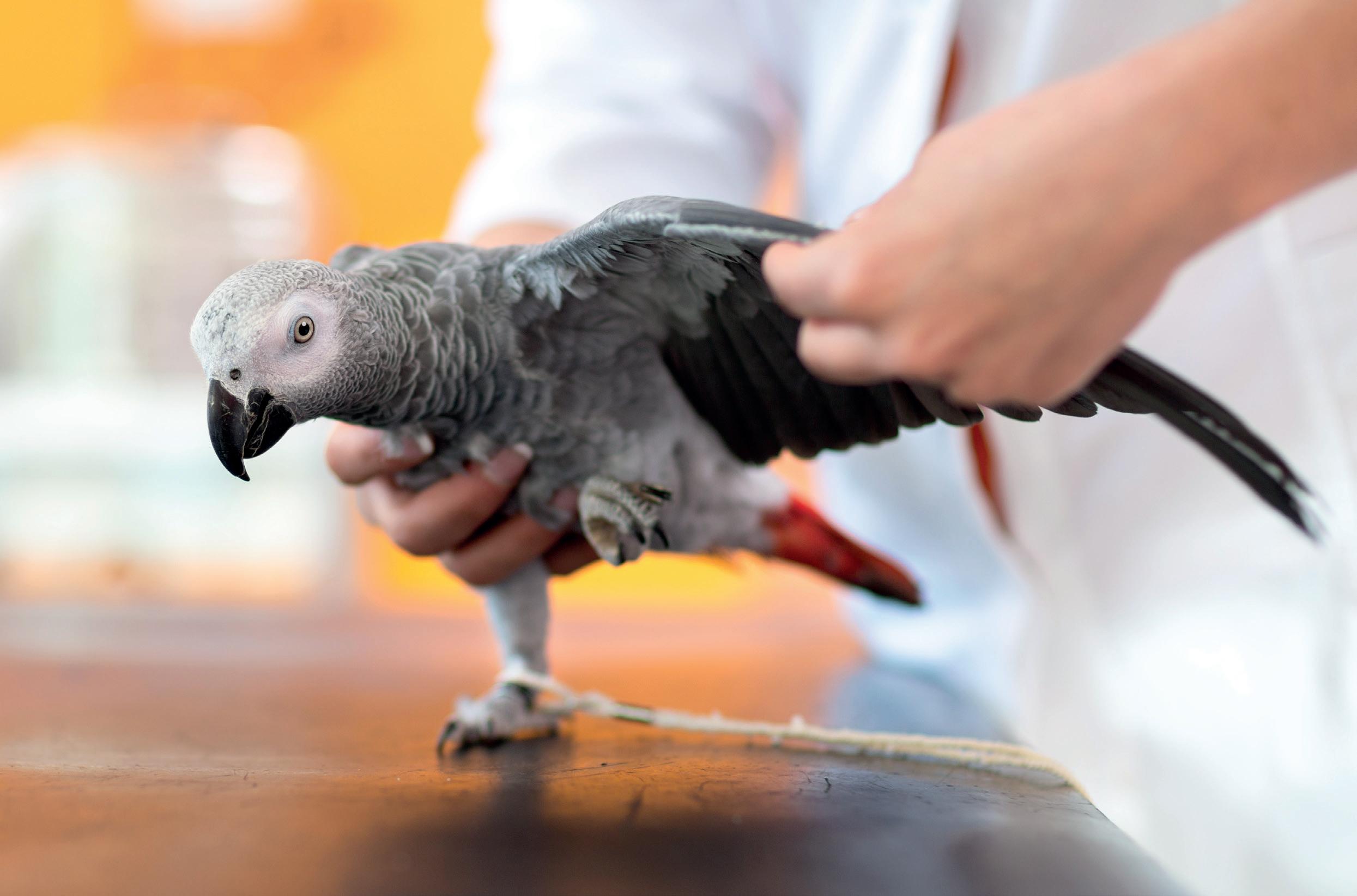
“A common herpes virus causes an acute, rapidly fatal, hepatitis in parrots, and is known as Pacheco’s Disease. This is most frequently encountered in recently imported birds in quarantine. It will spread rapidly and will wipe out a high percentage of the group in a few days. Polyomavirus generally afflicts young parrots and will result in sudden death, with pale skin and pin-point haemorrhages visible in the skin and around abdominal organs. Any birds that do survive (especially budgerigars) generally develop abnormal stunted feathering.”
“Circovirus is the cause of the highly unpleasant Psittacine Beak and Feather Disease (PBFD). This virus attacks young growing feather and beak tissue in fledgling birds and damages their immune system, so they have no resistance to other diseases. In budgerigars, it is known as French Moult, and although most infected birds will die, some will survive but with a damaged wing and tail feathers, so they can never fly and are hence known as runners. In most other parrots, infection is almost invariably fatal. The course of the disease varies with the age at infection and the infective dose of the virus. Very young chicks will die quickly, often dropping feathers by the handful first. Older birds will develop characteristic feather deformities or discolourations – white in black birds like the Vasa parrot or pink in African greys. See also Psittacine Beak & Feather Disease.”
“Avian Bornavirus is responsible for another devastating disease with a prolonged incubation period – Macaw Wasting Disease (so-called because it was first identified commonly in macaws), or Proventricular Dilatation Disease (PDD) or Proventricular Dilatation Syndrome (PDS). This virus is similar in its effects to Key-Gaskell Syndrome in cats or Grass Sickness in horses. The initial infection causes mild transient diarrhoea, from which most individuals recover. In a small percentage, there is damage to the nerves controlling the stomach, so that this organ becomes
43 SEPTEMBER 2022 Keeper Basics: Parrot Problems
stretched, thin-walled and bloated. Digestive efficiency is impaired, so affected birds will eat well but lose weight, commonly vomiting, and will pass undigested food items (especially seed kernels) in their droppings. Some birds will also show nervous signs such as tremors or incoordination. Like PBFD, the incubation period can be many months, making the source of infection difficult to define. It is also currently incurable, although isolated pet birds may be maintained by feeding soft foods and giving non-steroidal anti-inflammatory drugs (NSAIDs).”
Currently, these illnesses are incurable. Meaning preventative measures are the best defence for keepers to protect their birds. High levels of biosecurity are important to ensure that animals do not pick up, or pass on any new viruses. The use of a good quality animal-safe disinfectant such as F10 is a simple solution. This formula can be used in foot dips for outdoor aviaries, cleaning wipes for feeding tools and utensils, or even just to clean cages and equipment. A quarantine procedure is important for any bird being introduced to an existing group of birds. This quarantine process should last at least 10 days, ideally 30.
Other diseases
There are several other types of disease which commonly affect parrots. Bacterial diseases can be caused by a whole host of potential organisms. Some of the easier-toprevent ones are those that are passed on through our own activities. ‘Food poisoning’ bacteria such as E-coli and Salmonella can affect parrots, so keepers should exercise the same caution in preparing their animals’ food as their own. Fungal diseases are also often seen in young handreared chicks as yeast and spores can quickly build up in the bird’s trachea.

Parasites may also cause an issue if left untreated. Tapeworms and roundworms can sometimes be spotted protruding from the bird’s vent. These are most common in wild-caught birds, making them far less widespread in most UK hobbyist collections. Bird keepers should contact a vet to discuss treatments if they notice these parasites. Ticks can also pose a threat to aviary birds, particularly when
overgrown or hanging plants shroud the fencing. Although most ticks will simply drop off once they have consumed their fill of blood, the anticoagulant they leave behind can sometimes cause devastating reactions. Those with outdoor aviaries, particular in rural areas, should ensure that all vegetation is trimmed back and well maintained.
Another health concern which can be very common amongst new keepers is the use of aerosols and air fresheners. Parrots do not tolerate hazardous aerosols, even subtle fragrances from plug-in air fresheners can be very dangerous to birds. Keepers should avoid using these around the home where possible and certainly refrain from using them in direct contact, or even in the same room as a cage bird.
Treatments and products
Some of the most prolific health issues encountered by birds can be combatted with the use of a pelleted diet. Species-specific pelleted diets not only provide the entire nutrient profile that the animal needs and removes the necessity of supplements, but they give the keeper total control over the quantity consumed. If the keeper maintains a strict feeding regime with just a few treats, they know that the animal will not be pestering them for more of their favourite high-sugar, low-nutrient components of a seed diet. Food is not wasted and thrown onto the floor in favour of specific seeds, meaning the keeper knows exactly how much the bird has eaten and will not feel the temptation to ‘top up’ their food bowl.
Psittacus and Vetark supplements as well as F10 disinfectants are also important products to keep stocked. Not only do they have universal applications that will benefit almost any exotics keeper, but they can be used reactively to treat or prevent the spread of illness. Parrots also have extremely high metabolisms and expend a lot of their energy just keeping themselves warm. Thus, a sick parrot will require additional warmth, to allow them to focus their energy on recovery. Heat pads and infrared heat projectors can provide a lifeline to worried customers until they can see their vet.
44 SEPTEMBER 2022
FASCINATING FACT
The cryptic story of the New Forest Cicada

The New Forest Cicada (Cicadetta montana) is the only cicada species native to the UK and very possibly the last. C. montana has not been seen or heard in the UK since the year 2000. Despite countless projects aimed at recording and identifying the species’ call throughout the New Forest, this insect appears to have been lost from the UK’s woodlands indefinitely. Sadly, this is no surprise given that it has already been lost across most of its native range of Western Europe.
The lifecycle of C. montana is just as miraculous as other cicadas. Emerging from eggs after a reasonably long (up to 125 days) incubation period, the grubs bury deep into the soil where they can spend between six and 10 years. During this time, the nymphs will feed on the sap of plant roots. When they are finally ready to emerge, they will create a clay-like tunnel towards the surface of the soil. It is thought that this tunnel helps the insects determine the weather conditions above the surface. As a species that will only tolerate the warmest UK springs, the adult cicadas will sing from high in the trees at no less than 20°C. Due to
their extremely cryptic lifestyles, it is highly possible that the New Forest Cicada still lives here in England, beneath the soils of the New Forest.
The New Forest Cicada is one of the UK’s largest insects at 3cm in length. Due to its drastic decline, it has been listed as a priority species in the Natural Environment and Rural Communities (NERC) Act. Although it may be too late to save this highly endangered species, conservationists have their theories on why the New Forest cicada has seen such drastic declines. As well as wetter summers as a result of climate change, animal grazing has reduced the number of plants for the cicadas to lay their eggs and livestock may trample the nymphs’ tunnels, leaving them exposed to predators. The WWF reports that over 70% of land use in the UK can be attributed to agriculture and between 1970 and 2013, 56% of UK species saw a decline in population numbers. Even the New Forest Cicada, a species which shelters itself from human activity and is only seen once a decade is vulnerable to the effects of agriculture here in the UK.
Fascinating Fact
ENRICHMENT IDEAS
Bearded dragon diets

‘Enrichment’ can cover a whole range of topics. This can even stretch to the dietary needs of an animal. Bearded dragons are omnivorous lizards. This can be seen as a gold mine for enrichment opportunities. With a little research, even something as seemingly straightforward as feeding can bring a whole host of benefits. In the wild, bearded dragon diets change drastically as they mature. Juveniles will tend to feed on <90% insects, whereas adult males will feed on <90% plant matter (surprisingly, females will feed on a lower percentage of plant matter). Outback Australia experiences seasonal rains which naturally fluctuate the availability of different insects, the nutritional content of plant shoots, the abundance of flowers and much more. With a little planning, simulating these seasonal changes can help provide a pet bearded dragon with a very enriching diet.
Spring
Spring welcomes the fall of the first rains in the red centre. It is also frequently called the ‘wildflower season’ due to the high abundance of flowering plants. This makes it the perfect time to feed flowering plants such as dandelions, hibiscus, rose petals and pansies (providing they are clean are safe). An alternative to this would be to provide a commercial ‘flower mix’. Obesity is a common occurrence in bearded dragons so keepers must be careful but feeding sugary berries as treats during spring will help mimic that fresh wild plant growth. Lucky Reptile produces a ‘Bearded Dragon Candy’ which can be used sparingly to simulate this seasonal change. Birds will also be nesting during Spring and therefore the provision of some scrambled eggs will make an excellent addition to a bearded dragon’s diet. The rains tend to bring a good number of young insects and flies. Try incorporating smaller-sized locusts and a good number of curly-wing flies to simulate this seasonal change.
Summer
Summer is generally very hot but the monsoons towards the North of Australia mean it is also the season with the most rainfall. Increasing humidity within the enclosure on sporadic days throughout the season can help to mimic this rainfall. Dedicated keepers can go one step further by replacing their water dish to provide something large enough for the animal to soak in. Between spring and summer, locusts are most abundant and often grow to huge sizes. Try increasing the size of live foods and including a few large locusts for the dragon to hunt. The intense summer heat will impact plant growth, so adding prickly pear or more robust root vegetables to the animals’ usual leafy greens is a good idea.
Autumn
Autumn is warm and dry. This means bearded dragons are likely to be very active in searching for high-fat foods before the cooler temperatures begin to set in. A great way to exercise a bearded dragon (particularly a young one) is to allow calci-worms to pupate and turn into black soldier flies. Although these flies are harmless, they do look rather menacing and will buzz around the vivarium creating an excellent opportunity to chase them. An edible plant kit is also worth investing in during this time of year. Not only does it ensure there is a steady supply of fresh, healthy greens, but these leaves can be picked at different points as they grow and then scattered across the terrarium. This will force the dragon to search across the enclosure to find its food. At this point, dried commercial diets such as the ProRep Botanical Mix can begin to be incorporated into the main diet. Alongside fresh greens, the dried leaves will add new textures and simulate drier conditions. This should be provided throughout Autumn and Winter.
Winter
Winter is cold (sometimes freezing) and food becomes more scarce. In captivity, it is not necessary to force animals to struggle but replicating this seasonal change by providing greater amounts of smaller prey is a good idea. Wild dragons may encounter more termites and grubs during this time of year. Therefore, feeding lots of bean weevils, calci-worms and meal worms can help replicate their hunting behaviours. Chopping plant material into smaller pieces may also add a bit of enrichment loosely based on the environmental conditions they may encounter in the wild. During this time, reducing daylight hours and allowing the night-time temperatures to drop a little lower than usual can also support this seasonal change. The cooler temperatures mean that digestion will generally take a little longer in Winter. Although there’s no concrete evidence to suggest that wild bearded dragons adapt their diets accordingly, the addition of Lucky Reptiles’ dried herbs mix will increase the amount of crude fibre available and help this process.
alongside a well-rounded and nutritious diet.
46
SEPTEMBER 2022
Enrichment Ideas

Title 47 SEPTEMBER 2022 Everyone is talking about our Pet Insurance! We also offer dog, cat and horse insurance, all with a fantastic 10% multi-pet discount!* Get a quote TODAY at britishpetinsurance.co.uk or call us on 01444 708840. *10% discount on three pets or more from any species we cover within our pet insurance product range. British Pet Insurance Services is a trading name of Petcover EU Limited who is registered in England and Wales under number 10001319. Petcover EU Limited is authorised and regulated by the Financial Conduct Authority under reference number 747757.




























































































































 Leopard gecko (Eublepharis macularius)
Leopard gecko (Eublepharis macularius)





 Wax worm (Galleria mellonella)
Calci-worm (Hermetia illucens)
Buffalo worm (Alphitobius diaperinus)
Wax worm (Galleria mellonella)
Calci-worm (Hermetia illucens)
Buffalo worm (Alphitobius diaperinus)














 Male Common European Adder (Vipera berus)
Male Common European Adder (Vipera berus)

































 Lehmann’s poison frog “orange” (Oophaga lehmanni)
Lehmann’s poison frog “orange” (Oophaga lehmanni)











































 African grey (Psittacus sp.)
African grey (Psittacus sp.)







